Analysis of European Union Law and Policy
VerifiedAdded on 2020/07/22
|20
|6580
|164
AI Summary
This assignment provides a comprehensive overview of the European Union's legal framework and policy-making processes. It covers various topics such as competition law, debt crisis management, and intellectual property rights, highlighting the EU's efforts to promote economic integration and stability. The analysis also touches on issues related to university-industry technology transfer, products liability law, and sports law in the EU context.
Contribute Materials
Your contribution can guide someone’s learning journey. Share your
documents today.
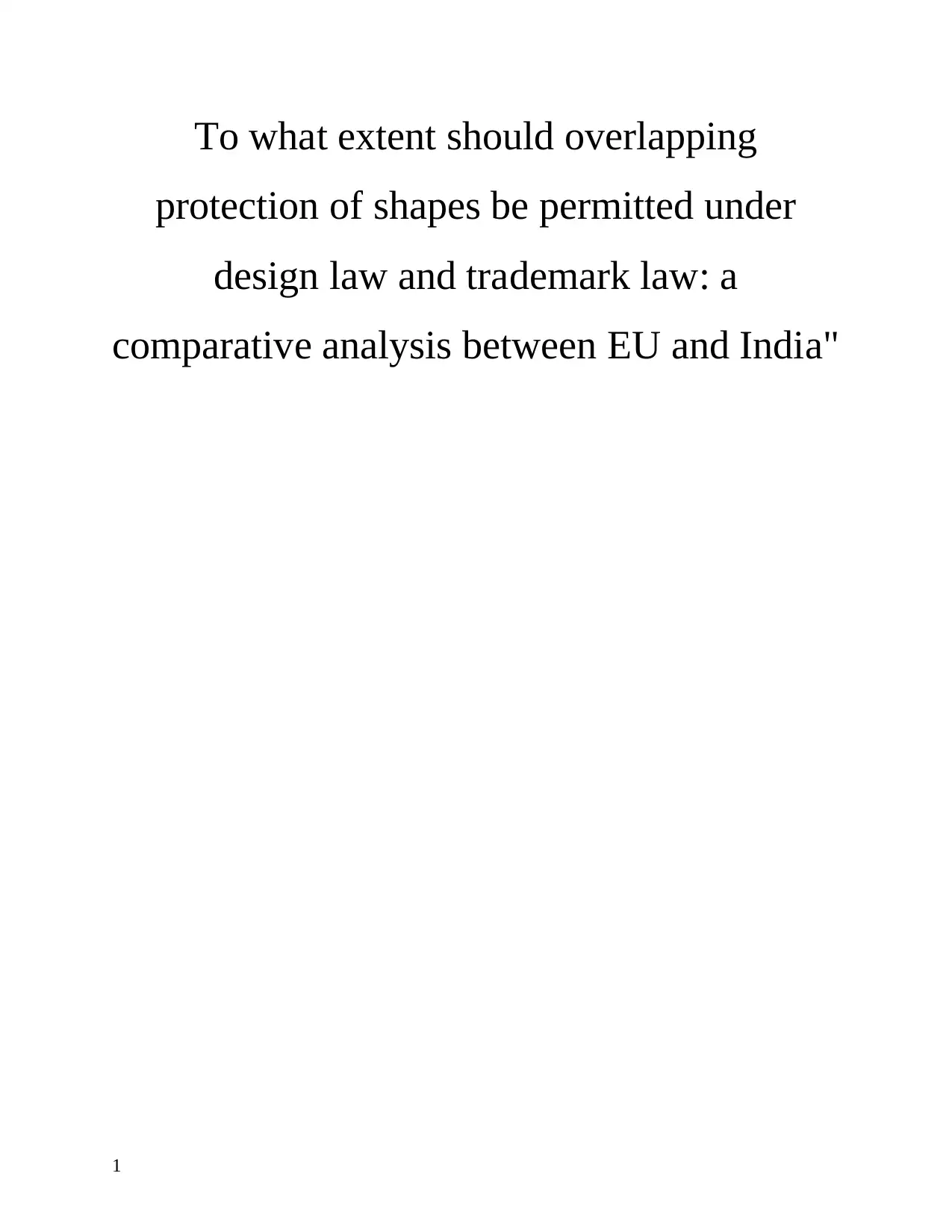
To what extent should overlapping
protection of shapes be permitted under
design law and trademark law: a
comparative analysis between EU and India"
1
protection of shapes be permitted under
design law and trademark law: a
comparative analysis between EU and India"
1
Secure Best Marks with AI Grader
Need help grading? Try our AI Grader for instant feedback on your assignments.
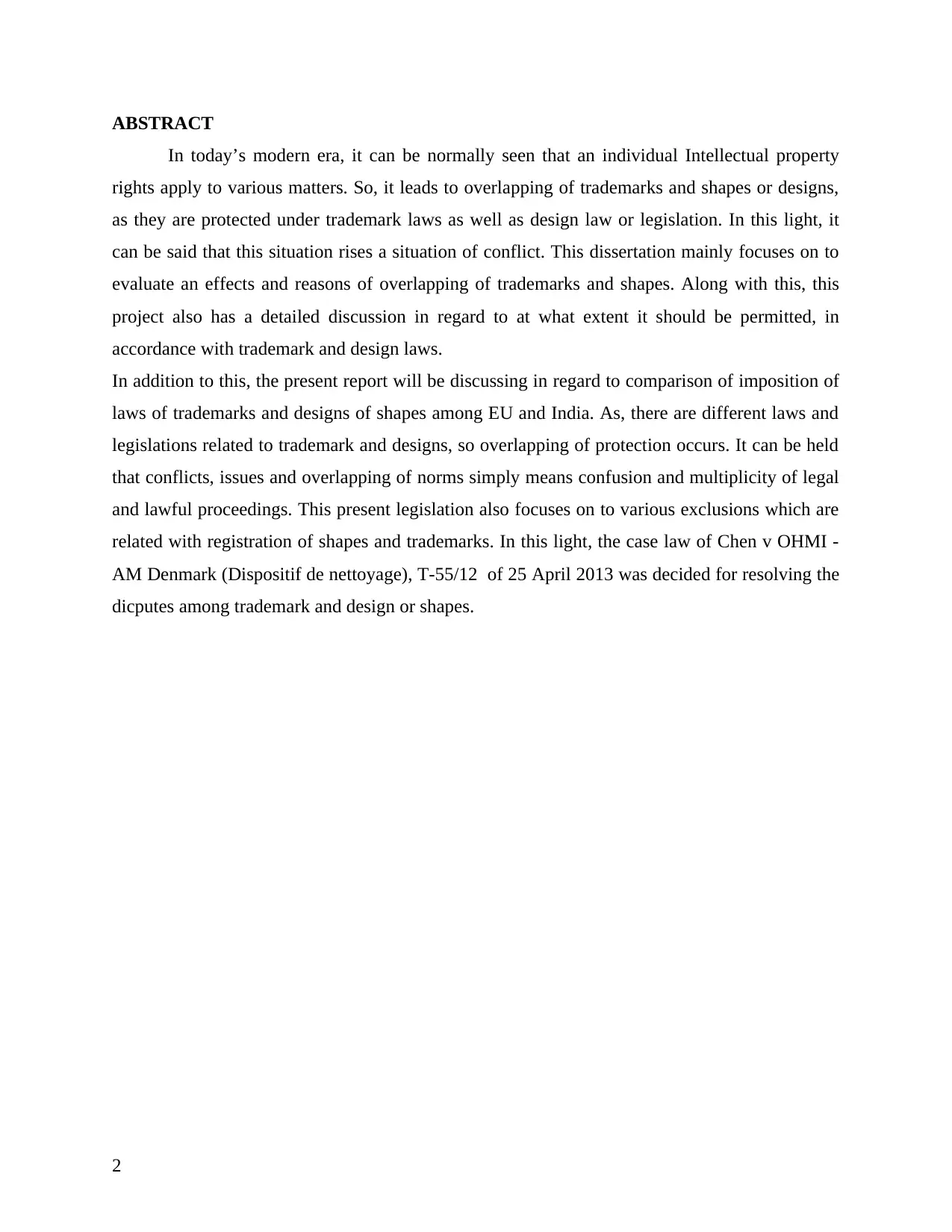
ABSTRACT
In today’s modern era, it can be normally seen that an individual Intellectual property
rights apply to various matters. So, it leads to overlapping of trademarks and shapes or designs,
as they are protected under trademark laws as well as design law or legislation. In this light, it
can be said that this situation rises a situation of conflict. This dissertation mainly focuses on to
evaluate an effects and reasons of overlapping of trademarks and shapes. Along with this, this
project also has a detailed discussion in regard to at what extent it should be permitted, in
accordance with trademark and design laws.
In addition to this, the present report will be discussing in regard to comparison of imposition of
laws of trademarks and designs of shapes among EU and India. As, there are different laws and
legislations related to trademark and designs, so overlapping of protection occurs. It can be held
that conflicts, issues and overlapping of norms simply means confusion and multiplicity of legal
and lawful proceedings. This present legislation also focuses on to various exclusions which are
related with registration of shapes and trademarks. In this light, the case law of Chen v OHMI -
AM Denmark (Dispositif de nettoyage), T-55/12 of 25 April 2013 was decided for resolving the
dicputes among trademark and design or shapes.
2
In today’s modern era, it can be normally seen that an individual Intellectual property
rights apply to various matters. So, it leads to overlapping of trademarks and shapes or designs,
as they are protected under trademark laws as well as design law or legislation. In this light, it
can be said that this situation rises a situation of conflict. This dissertation mainly focuses on to
evaluate an effects and reasons of overlapping of trademarks and shapes. Along with this, this
project also has a detailed discussion in regard to at what extent it should be permitted, in
accordance with trademark and design laws.
In addition to this, the present report will be discussing in regard to comparison of imposition of
laws of trademarks and designs of shapes among EU and India. As, there are different laws and
legislations related to trademark and designs, so overlapping of protection occurs. It can be held
that conflicts, issues and overlapping of norms simply means confusion and multiplicity of legal
and lawful proceedings. This present legislation also focuses on to various exclusions which are
related with registration of shapes and trademarks. In this light, the case law of Chen v OHMI -
AM Denmark (Dispositif de nettoyage), T-55/12 of 25 April 2013 was decided for resolving the
dicputes among trademark and design or shapes.
2

Contents
CHAPTER 1: INTRODUCTION....................................................................................................4
1.0 Overview................................................................................................................................4
1.1 Structure of Research.............................................................................................................5
1.3 Purpose and Focus of search..................................................................................................6
1.4 Research Questions................................................................................................................7
1.5 Framework and Analysis.......................................................................................................7
CHAPTER 2: EUROPEAN PERSPECTIVE .................................................................................9
2.1 Introduction............................................................................................................................9
2.2 Legal evaluation on industrial design protection in Europe ...............................................10
REFERENCES..............................................................................................................................16
3
CHAPTER 1: INTRODUCTION....................................................................................................4
1.0 Overview................................................................................................................................4
1.1 Structure of Research.............................................................................................................5
1.3 Purpose and Focus of search..................................................................................................6
1.4 Research Questions................................................................................................................7
1.5 Framework and Analysis.......................................................................................................7
CHAPTER 2: EUROPEAN PERSPECTIVE .................................................................................9
2.1 Introduction............................................................................................................................9
2.2 Legal evaluation on industrial design protection in Europe ...............................................10
REFERENCES..............................................................................................................................16
3

CHAPTER 1: INTRODUCTION
1.0 Overview
The economy of this modern times is based on appropriate knowledge. Intellectual
property are those rights which are allotted for the creation of an intellect in accordance to which
a monopoly is being allotted by law to designated owners These inventions can be in the form of
literary and artistic works, symbols and other names and images that are used while performing
commerce and trades of goods and services 1. It is a notable fact that there are two types of
intellectual property. These can be well defined as Industrial property, which involves patents for
inventions as well as trademarks and Industrial designs with geographical indications.
In accordance with the provisions of trademark act, it can be said that there are different
aspects for which cited act provides protection for the utilisation of trademarks in EU.2 A
trademark is a way which distinguishes itself from another. In the context of a corporate world, it
can be said that a trademark is a concept which renders a particular product of an organization
with a separate identity which is different from others. It can be noted that trade mark can be
classified as name, word, logo, shapes and symbols or design etc.
On the other hand, Registered Design act is a legislation which came into force in entire
European Union which has a concern with copyright and related act as well as shapes and other
patents.
This research mainly focuses on to overlapping of the protection given to shapes under
trademark and design law be authorised. It means that shapes and other sorts of intellectual
property are given protection under both Trademarks law and design legislation. Therefore, this
situation arises consequences of conflicts and issues 3. Also, this research emphasises on to
provide a clear understanding in regard to clarifying the ways and methods in which the various
shapes, logos and other types of Intellectual property rights can be characterised. Also, in what
way protection is allotted to them. Moreover, this research also defines the situations in which
1 Coduto DP. Foundation design: principles and practices. Pearson; 2015 Feb 3.
2 Dick W, Carey L, Carey JO. The systematic design of instruction. Pearson Higher Ed;
2014 Feb 4.
3 Johnson PF. Purchasing and supply management. McGraw-Hill Higher Education; 2014
Oct 2
4
1.0 Overview
The economy of this modern times is based on appropriate knowledge. Intellectual
property are those rights which are allotted for the creation of an intellect in accordance to which
a monopoly is being allotted by law to designated owners These inventions can be in the form of
literary and artistic works, symbols and other names and images that are used while performing
commerce and trades of goods and services 1. It is a notable fact that there are two types of
intellectual property. These can be well defined as Industrial property, which involves patents for
inventions as well as trademarks and Industrial designs with geographical indications.
In accordance with the provisions of trademark act, it can be said that there are different
aspects for which cited act provides protection for the utilisation of trademarks in EU.2 A
trademark is a way which distinguishes itself from another. In the context of a corporate world, it
can be said that a trademark is a concept which renders a particular product of an organization
with a separate identity which is different from others. It can be noted that trade mark can be
classified as name, word, logo, shapes and symbols or design etc.
On the other hand, Registered Design act is a legislation which came into force in entire
European Union which has a concern with copyright and related act as well as shapes and other
patents.
This research mainly focuses on to overlapping of the protection given to shapes under
trademark and design law be authorised. It means that shapes and other sorts of intellectual
property are given protection under both Trademarks law and design legislation. Therefore, this
situation arises consequences of conflicts and issues 3. Also, this research emphasises on to
provide a clear understanding in regard to clarifying the ways and methods in which the various
shapes, logos and other types of Intellectual property rights can be characterised. Also, in what
way protection is allotted to them. Moreover, this research also defines the situations in which
1 Coduto DP. Foundation design: principles and practices. Pearson; 2015 Feb 3.
2 Dick W, Carey L, Carey JO. The systematic design of instruction. Pearson Higher Ed;
2014 Feb 4.
3 Johnson PF. Purchasing and supply management. McGraw-Hill Higher Education; 2014
Oct 2
4
Paraphrase This Document
Need a fresh take? Get an instant paraphrase of this document with our AI Paraphraser
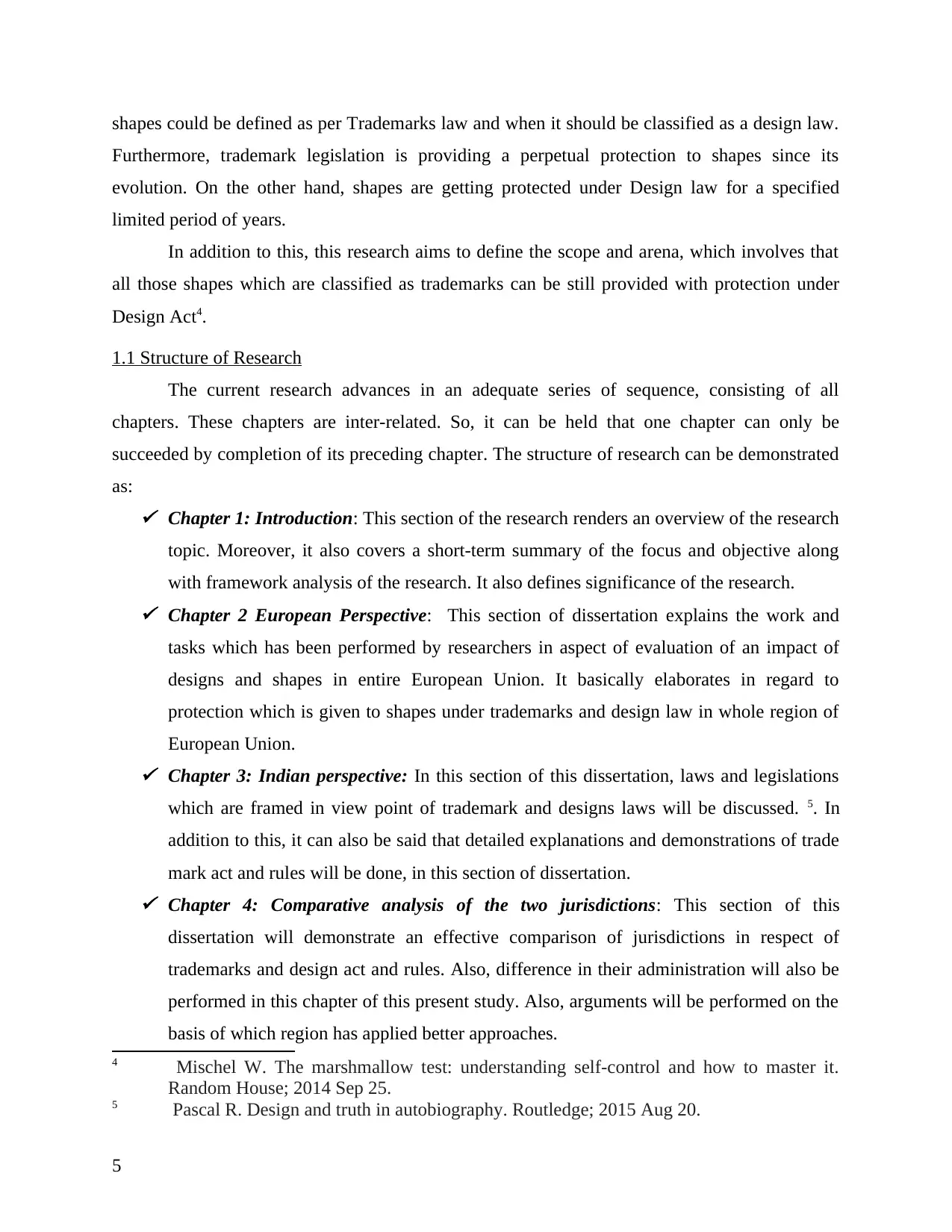
shapes could be defined as per Trademarks law and when it should be classified as a design law.
Furthermore, trademark legislation is providing a perpetual protection to shapes since its
evolution. On the other hand, shapes are getting protected under Design law for a specified
limited period of years.
In addition to this, this research aims to define the scope and arena, which involves that
all those shapes which are classified as trademarks can be still provided with protection under
Design Act4.
1.1 Structure of Research
The current research advances in an adequate series of sequence, consisting of all
chapters. These chapters are inter-related. So, it can be held that one chapter can only be
succeeded by completion of its preceding chapter. The structure of research can be demonstrated
as: Chapter 1: Introduction: This section of the research renders an overview of the research
topic. Moreover, it also covers a short-term summary of the focus and objective along
with framework analysis of the research. It also defines significance of the research. Chapter 2 European Perspective: This section of dissertation explains the work and
tasks which has been performed by researchers in aspect of evaluation of an impact of
designs and shapes in entire European Union. It basically elaborates in regard to
protection which is given to shapes under trademarks and design law in whole region of
European Union. Chapter 3: Indian perspective: In this section of this dissertation, laws and legislations
which are framed in view point of trademark and designs laws will be discussed. 5. In
addition to this, it can also be said that detailed explanations and demonstrations of trade
mark act and rules will be done, in this section of dissertation. Chapter 4: Comparative analysis of the two jurisdictions: This section of this
dissertation will demonstrate an effective comparison of jurisdictions in respect of
trademarks and design act and rules. Also, difference in their administration will also be
performed in this chapter of this present study. Also, arguments will be performed on the
basis of which region has applied better approaches.
4 Mischel W. The marshmallow test: understanding self-control and how to master it.
Random House; 2014 Sep 25.
5 Pascal R. Design and truth in autobiography. Routledge; 2015 Aug 20.
5
Furthermore, trademark legislation is providing a perpetual protection to shapes since its
evolution. On the other hand, shapes are getting protected under Design law for a specified
limited period of years.
In addition to this, this research aims to define the scope and arena, which involves that
all those shapes which are classified as trademarks can be still provided with protection under
Design Act4.
1.1 Structure of Research
The current research advances in an adequate series of sequence, consisting of all
chapters. These chapters are inter-related. So, it can be held that one chapter can only be
succeeded by completion of its preceding chapter. The structure of research can be demonstrated
as: Chapter 1: Introduction: This section of the research renders an overview of the research
topic. Moreover, it also covers a short-term summary of the focus and objective along
with framework analysis of the research. It also defines significance of the research. Chapter 2 European Perspective: This section of dissertation explains the work and
tasks which has been performed by researchers in aspect of evaluation of an impact of
designs and shapes in entire European Union. It basically elaborates in regard to
protection which is given to shapes under trademarks and design law in whole region of
European Union. Chapter 3: Indian perspective: In this section of this dissertation, laws and legislations
which are framed in view point of trademark and designs laws will be discussed. 5. In
addition to this, it can also be said that detailed explanations and demonstrations of trade
mark act and rules will be done, in this section of dissertation. Chapter 4: Comparative analysis of the two jurisdictions: This section of this
dissertation will demonstrate an effective comparison of jurisdictions in respect of
trademarks and design act and rules. Also, difference in their administration will also be
performed in this chapter of this present study. Also, arguments will be performed on the
basis of which region has applied better approaches.
4 Mischel W. The marshmallow test: understanding self-control and how to master it.
Random House; 2014 Sep 25.
5 Pascal R. Design and truth in autobiography. Routledge; 2015 Aug 20.
5
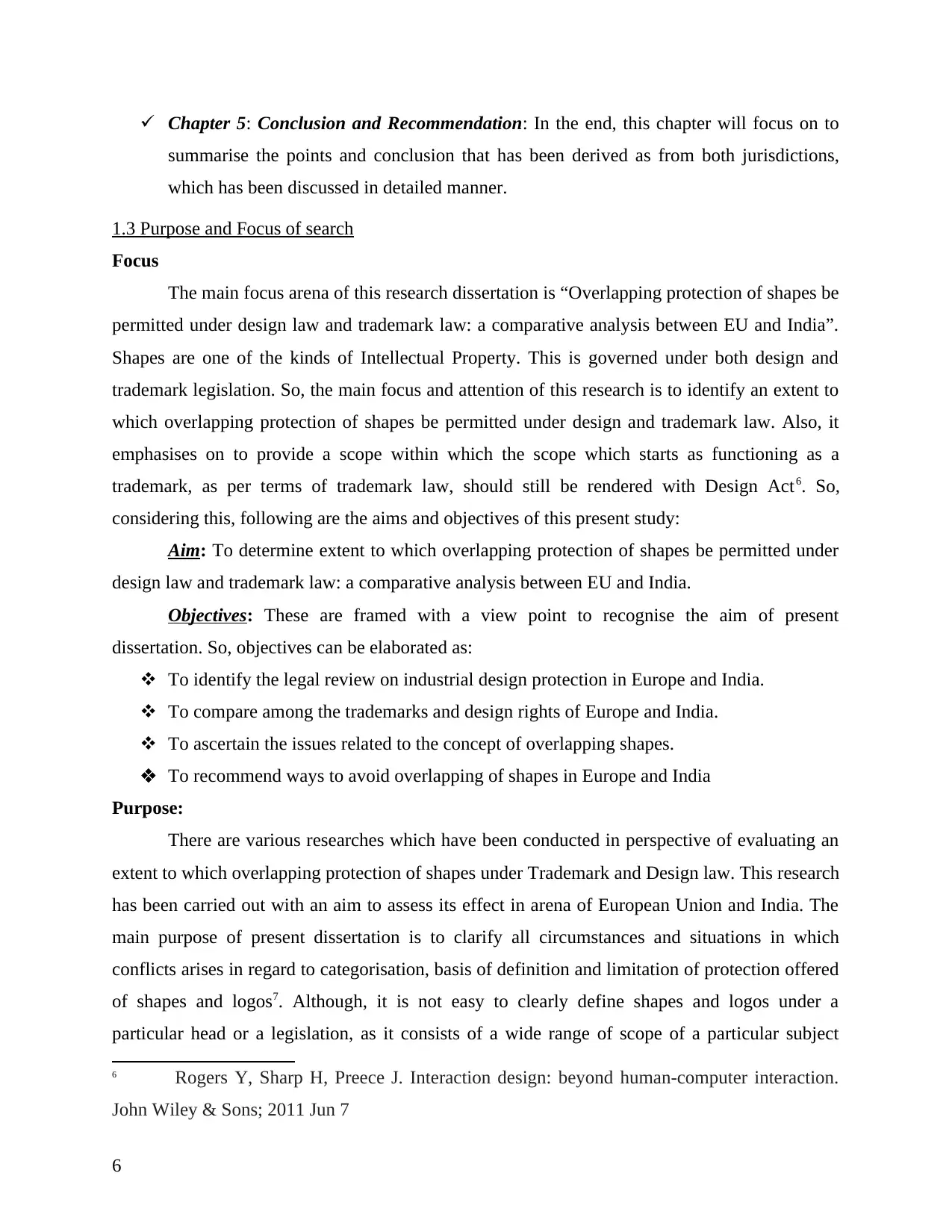
Chapter 5: Conclusion and Recommendation: In the end, this chapter will focus on to
summarise the points and conclusion that has been derived as from both jurisdictions,
which has been discussed in detailed manner.
1.3 Purpose and Focus of search
Focus
The main focus arena of this research dissertation is “Overlapping protection of shapes be
permitted under design law and trademark law: a comparative analysis between EU and India”.
Shapes are one of the kinds of Intellectual Property. This is governed under both design and
trademark legislation. So, the main focus and attention of this research is to identify an extent to
which overlapping protection of shapes be permitted under design and trademark law. Also, it
emphasises on to provide a scope within which the scope which starts as functioning as a
trademark, as per terms of trademark law, should still be rendered with Design Act6. So,
considering this, following are the aims and objectives of this present study:
Aim: To determine extent to which overlapping protection of shapes be permitted under
design law and trademark law: a comparative analysis between EU and India.
Objectives: These are framed with a view point to recognise the aim of present
dissertation. So, objectives can be elaborated as:
To identify the legal review on industrial design protection in Europe and India.
To compare among the trademarks and design rights of Europe and India.
To ascertain the issues related to the concept of overlapping shapes.
To recommend ways to avoid overlapping of shapes in Europe and India
Purpose:
There are various researches which have been conducted in perspective of evaluating an
extent to which overlapping protection of shapes under Trademark and Design law. This research
has been carried out with an aim to assess its effect in arena of European Union and India. The
main purpose of present dissertation is to clarify all circumstances and situations in which
conflicts arises in regard to categorisation, basis of definition and limitation of protection offered
of shapes and logos7. Although, it is not easy to clearly define shapes and logos under a
particular head or a legislation, as it consists of a wide range of scope of a particular subject
6 Rogers Y, Sharp H, Preece J. Interaction design: beyond human-computer interaction.
John Wiley & Sons; 2011 Jun 7
6
summarise the points and conclusion that has been derived as from both jurisdictions,
which has been discussed in detailed manner.
1.3 Purpose and Focus of search
Focus
The main focus arena of this research dissertation is “Overlapping protection of shapes be
permitted under design law and trademark law: a comparative analysis between EU and India”.
Shapes are one of the kinds of Intellectual Property. This is governed under both design and
trademark legislation. So, the main focus and attention of this research is to identify an extent to
which overlapping protection of shapes be permitted under design and trademark law. Also, it
emphasises on to provide a scope within which the scope which starts as functioning as a
trademark, as per terms of trademark law, should still be rendered with Design Act6. So,
considering this, following are the aims and objectives of this present study:
Aim: To determine extent to which overlapping protection of shapes be permitted under
design law and trademark law: a comparative analysis between EU and India.
Objectives: These are framed with a view point to recognise the aim of present
dissertation. So, objectives can be elaborated as:
To identify the legal review on industrial design protection in Europe and India.
To compare among the trademarks and design rights of Europe and India.
To ascertain the issues related to the concept of overlapping shapes.
To recommend ways to avoid overlapping of shapes in Europe and India
Purpose:
There are various researches which have been conducted in perspective of evaluating an
extent to which overlapping protection of shapes under Trademark and Design law. This research
has been carried out with an aim to assess its effect in arena of European Union and India. The
main purpose of present dissertation is to clarify all circumstances and situations in which
conflicts arises in regard to categorisation, basis of definition and limitation of protection offered
of shapes and logos7. Although, it is not easy to clearly define shapes and logos under a
particular head or a legislation, as it consists of a wide range of scope of a particular subject
6 Rogers Y, Sharp H, Preece J. Interaction design: beyond human-computer interaction.
John Wiley & Sons; 2011 Jun 7
6
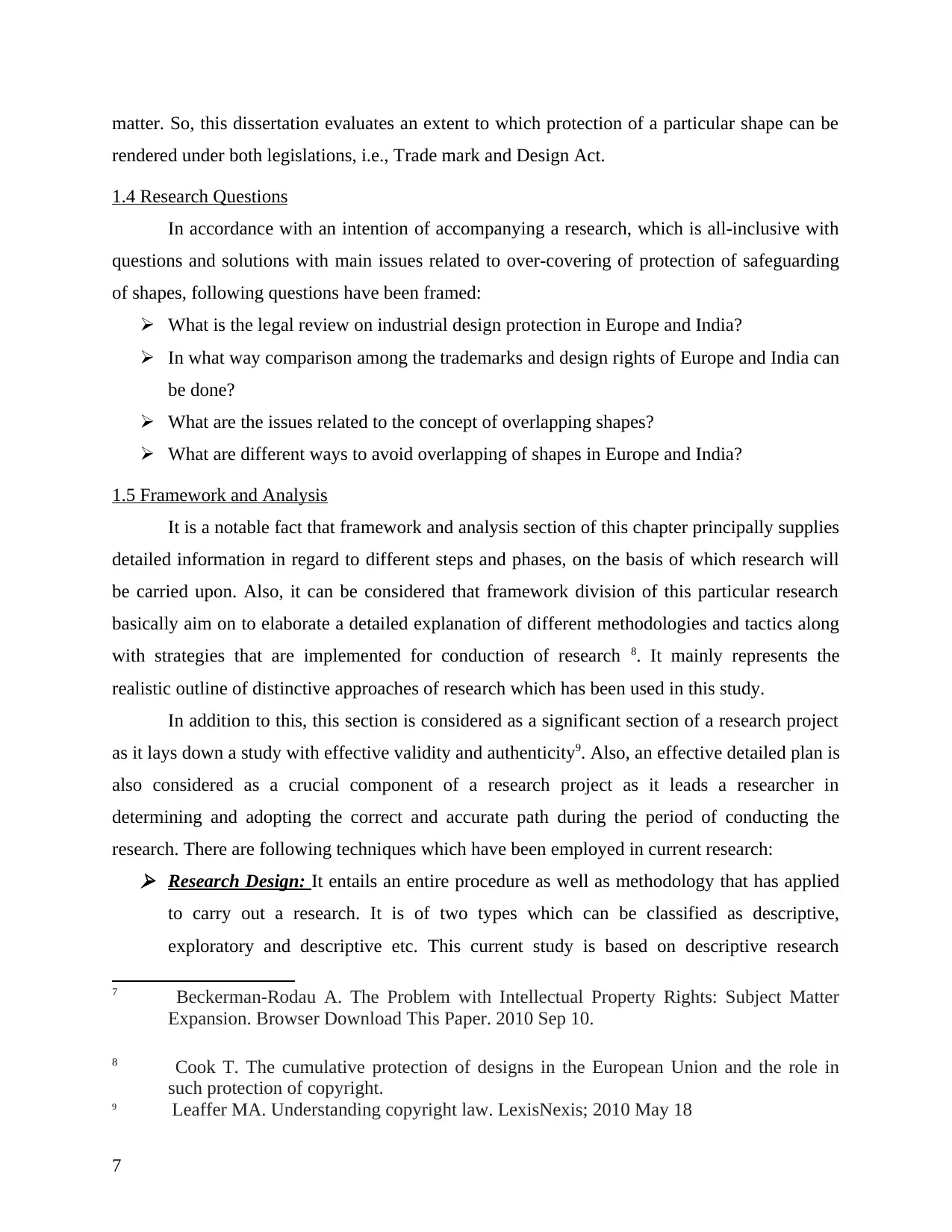
matter. So, this dissertation evaluates an extent to which protection of a particular shape can be
rendered under both legislations, i.e., Trade mark and Design Act.
1.4 Research Questions
In accordance with an intention of accompanying a research, which is all-inclusive with
questions and solutions with main issues related to over-covering of protection of safeguarding
of shapes, following questions have been framed:
What is the legal review on industrial design protection in Europe and India?
In what way comparison among the trademarks and design rights of Europe and India can
be done?
What are the issues related to the concept of overlapping shapes?
What are different ways to avoid overlapping of shapes in Europe and India?
1.5 Framework and Analysis
It is a notable fact that framework and analysis section of this chapter principally supplies
detailed information in regard to different steps and phases, on the basis of which research will
be carried upon. Also, it can be considered that framework division of this particular research
basically aim on to elaborate a detailed explanation of different methodologies and tactics along
with strategies that are implemented for conduction of research 8. It mainly represents the
realistic outline of distinctive approaches of research which has been used in this study.
In addition to this, this section is considered as a significant section of a research project
as it lays down a study with effective validity and authenticity9. Also, an effective detailed plan is
also considered as a crucial component of a research project as it leads a researcher in
determining and adopting the correct and accurate path during the period of conducting the
research. There are following techniques which have been employed in current research: Research Design: It entails an entire procedure as well as methodology that has applied
to carry out a research. It is of two types which can be classified as descriptive,
exploratory and descriptive etc. This current study is based on descriptive research
7 Beckerman-Rodau A. The Problem with Intellectual Property Rights: Subject Matter
Expansion. Browser Download This Paper. 2010 Sep 10.
8 Cook T. The cumulative protection of designs in the European Union and the role in
such protection of copyright.
9 Leaffer MA. Understanding copyright law. LexisNexis; 2010 May 18
7
rendered under both legislations, i.e., Trade mark and Design Act.
1.4 Research Questions
In accordance with an intention of accompanying a research, which is all-inclusive with
questions and solutions with main issues related to over-covering of protection of safeguarding
of shapes, following questions have been framed:
What is the legal review on industrial design protection in Europe and India?
In what way comparison among the trademarks and design rights of Europe and India can
be done?
What are the issues related to the concept of overlapping shapes?
What are different ways to avoid overlapping of shapes in Europe and India?
1.5 Framework and Analysis
It is a notable fact that framework and analysis section of this chapter principally supplies
detailed information in regard to different steps and phases, on the basis of which research will
be carried upon. Also, it can be considered that framework division of this particular research
basically aim on to elaborate a detailed explanation of different methodologies and tactics along
with strategies that are implemented for conduction of research 8. It mainly represents the
realistic outline of distinctive approaches of research which has been used in this study.
In addition to this, this section is considered as a significant section of a research project
as it lays down a study with effective validity and authenticity9. Also, an effective detailed plan is
also considered as a crucial component of a research project as it leads a researcher in
determining and adopting the correct and accurate path during the period of conducting the
research. There are following techniques which have been employed in current research: Research Design: It entails an entire procedure as well as methodology that has applied
to carry out a research. It is of two types which can be classified as descriptive,
exploratory and descriptive etc. This current study is based on descriptive research
7 Beckerman-Rodau A. The Problem with Intellectual Property Rights: Subject Matter
Expansion. Browser Download This Paper. 2010 Sep 10.
8 Cook T. The cumulative protection of designs in the European Union and the role in
such protection of copyright.
9 Leaffer MA. Understanding copyright law. LexisNexis; 2010 May 18
7
Secure Best Marks with AI Grader
Need help grading? Try our AI Grader for instant feedback on your assignments.
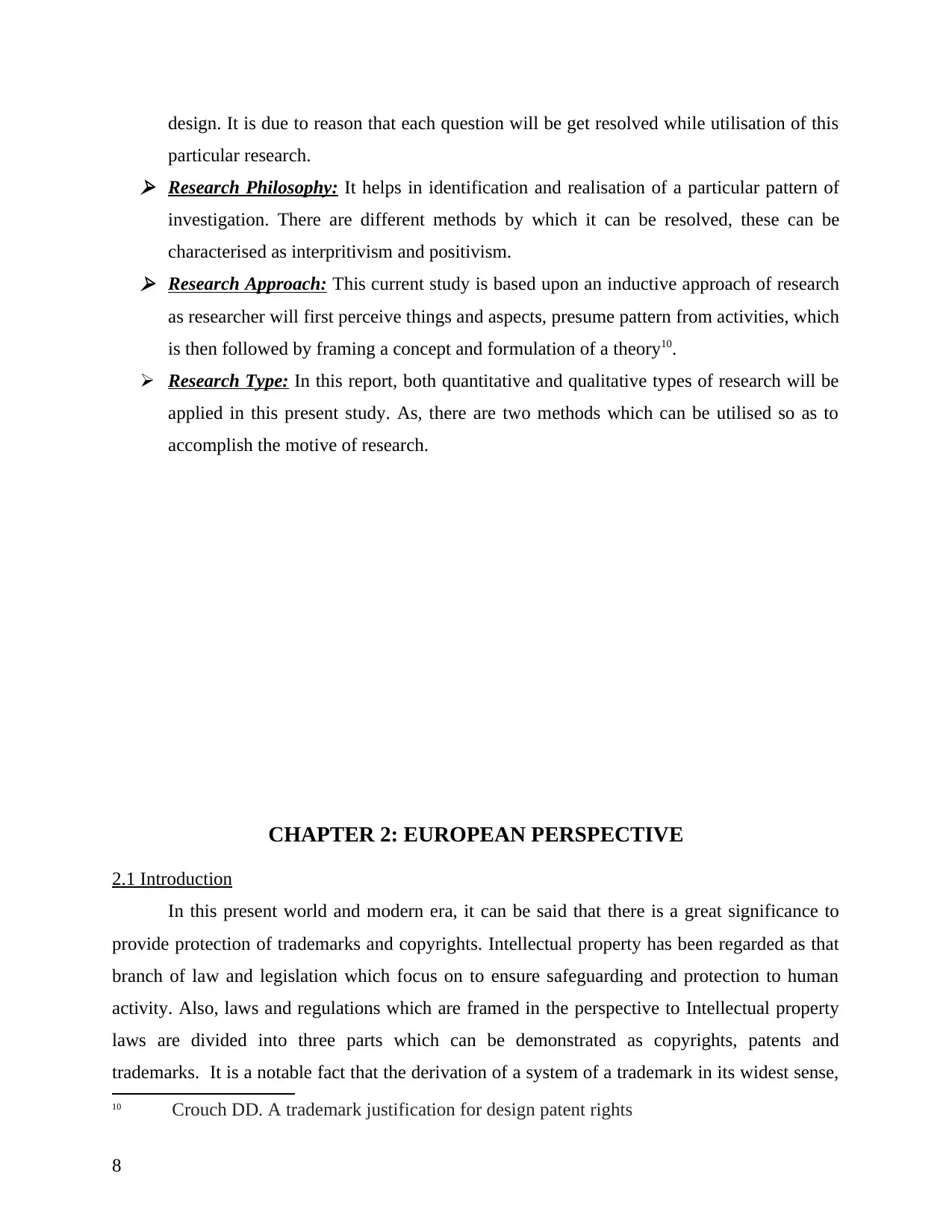
design. It is due to reason that each question will be get resolved while utilisation of this
particular research. Research Philosophy: It helps in identification and realisation of a particular pattern of
investigation. There are different methods by which it can be resolved, these can be
characterised as interpritivism and positivism. Research Approach: This current study is based upon an inductive approach of research
as researcher will first perceive things and aspects, presume pattern from activities, which
is then followed by framing a concept and formulation of a theory10.
Research Type: In this report, both quantitative and qualitative types of research will be
applied in this present study. As, there are two methods which can be utilised so as to
accomplish the motive of research.
CHAPTER 2: EUROPEAN PERSPECTIVE
2.1 Introduction
In this present world and modern era, it can be said that there is a great significance to
provide protection of trademarks and copyrights. Intellectual property has been regarded as that
branch of law and legislation which focus on to ensure safeguarding and protection to human
activity. Also, laws and regulations which are framed in the perspective to Intellectual property
laws are divided into three parts which can be demonstrated as copyrights, patents and
trademarks. It is a notable fact that the derivation of a system of a trademark in its widest sense,
10 Crouch DD. A trademark justification for design patent rights
8
particular research. Research Philosophy: It helps in identification and realisation of a particular pattern of
investigation. There are different methods by which it can be resolved, these can be
characterised as interpritivism and positivism. Research Approach: This current study is based upon an inductive approach of research
as researcher will first perceive things and aspects, presume pattern from activities, which
is then followed by framing a concept and formulation of a theory10.
Research Type: In this report, both quantitative and qualitative types of research will be
applied in this present study. As, there are two methods which can be utilised so as to
accomplish the motive of research.
CHAPTER 2: EUROPEAN PERSPECTIVE
2.1 Introduction
In this present world and modern era, it can be said that there is a great significance to
provide protection of trademarks and copyrights. Intellectual property has been regarded as that
branch of law and legislation which focus on to ensure safeguarding and protection to human
activity. Also, laws and regulations which are framed in the perspective to Intellectual property
laws are divided into three parts which can be demonstrated as copyrights, patents and
trademarks. It is a notable fact that the derivation of a system of a trademark in its widest sense,
10 Crouch DD. A trademark justification for design patent rights
8
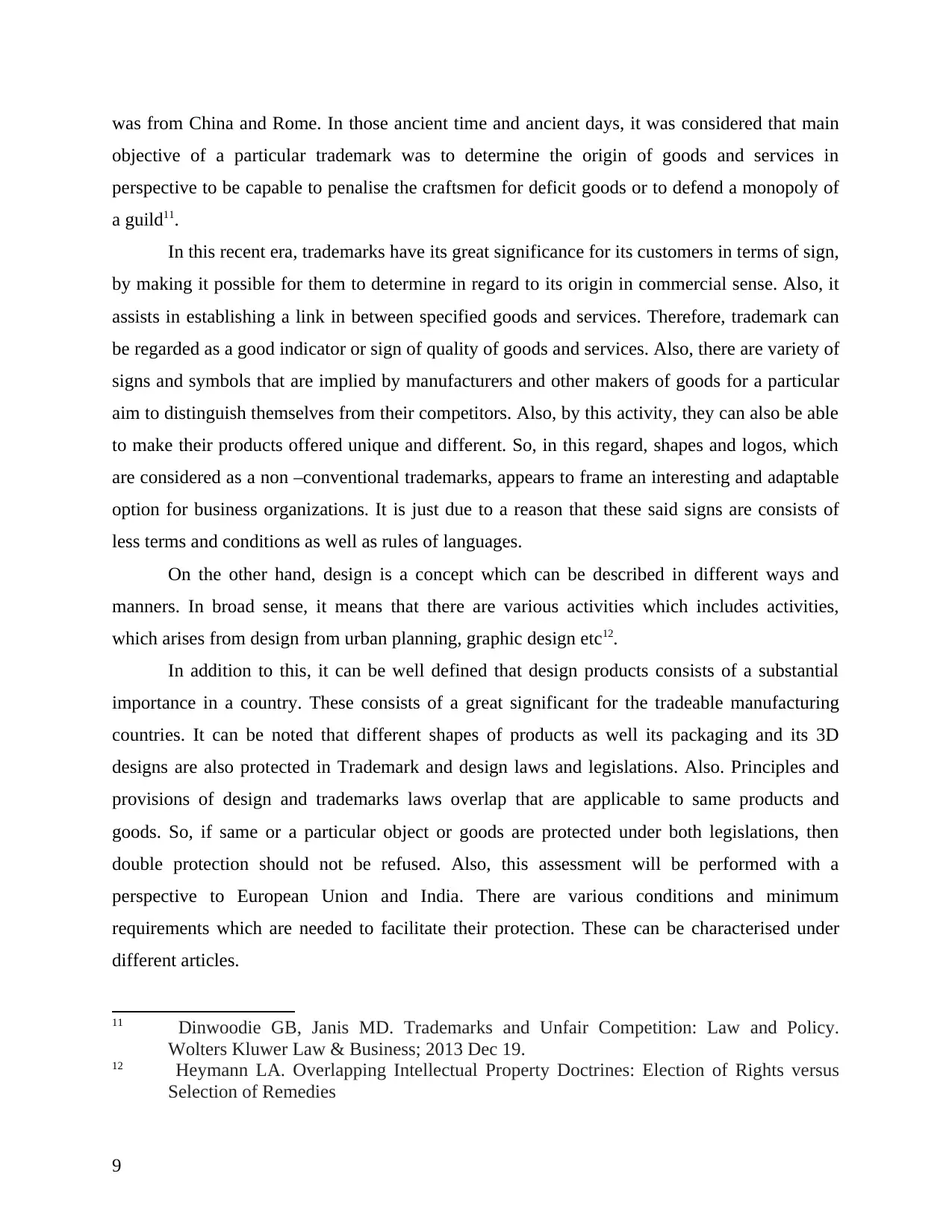
was from China and Rome. In those ancient time and ancient days, it was considered that main
objective of a particular trademark was to determine the origin of goods and services in
perspective to be capable to penalise the craftsmen for deficit goods or to defend a monopoly of
a guild11.
In this recent era, trademarks have its great significance for its customers in terms of sign,
by making it possible for them to determine in regard to its origin in commercial sense. Also, it
assists in establishing a link in between specified goods and services. Therefore, trademark can
be regarded as a good indicator or sign of quality of goods and services. Also, there are variety of
signs and symbols that are implied by manufacturers and other makers of goods for a particular
aim to distinguish themselves from their competitors. Also, by this activity, they can also be able
to make their products offered unique and different. So, in this regard, shapes and logos, which
are considered as a non –conventional trademarks, appears to frame an interesting and adaptable
option for business organizations. It is just due to a reason that these said signs are consists of
less terms and conditions as well as rules of languages.
On the other hand, design is a concept which can be described in different ways and
manners. In broad sense, it means that there are various activities which includes activities,
which arises from design from urban planning, graphic design etc12.
In addition to this, it can be well defined that design products consists of a substantial
importance in a country. These consists of a great significant for the tradeable manufacturing
countries. It can be noted that different shapes of products as well its packaging and its 3D
designs are also protected in Trademark and design laws and legislations. Also. Principles and
provisions of design and trademarks laws overlap that are applicable to same products and
goods. So, if same or a particular object or goods are protected under both legislations, then
double protection should not be refused. Also, this assessment will be performed with a
perspective to European Union and India. There are various conditions and minimum
requirements which are needed to facilitate their protection. These can be characterised under
different articles.
11 Dinwoodie GB, Janis MD. Trademarks and Unfair Competition: Law and Policy.
Wolters Kluwer Law & Business; 2013 Dec 19.
12 Heymann LA. Overlapping Intellectual Property Doctrines: Election of Rights versus
Selection of Remedies
9
objective of a particular trademark was to determine the origin of goods and services in
perspective to be capable to penalise the craftsmen for deficit goods or to defend a monopoly of
a guild11.
In this recent era, trademarks have its great significance for its customers in terms of sign,
by making it possible for them to determine in regard to its origin in commercial sense. Also, it
assists in establishing a link in between specified goods and services. Therefore, trademark can
be regarded as a good indicator or sign of quality of goods and services. Also, there are variety of
signs and symbols that are implied by manufacturers and other makers of goods for a particular
aim to distinguish themselves from their competitors. Also, by this activity, they can also be able
to make their products offered unique and different. So, in this regard, shapes and logos, which
are considered as a non –conventional trademarks, appears to frame an interesting and adaptable
option for business organizations. It is just due to a reason that these said signs are consists of
less terms and conditions as well as rules of languages.
On the other hand, design is a concept which can be described in different ways and
manners. In broad sense, it means that there are various activities which includes activities,
which arises from design from urban planning, graphic design etc12.
In addition to this, it can be well defined that design products consists of a substantial
importance in a country. These consists of a great significant for the tradeable manufacturing
countries. It can be noted that different shapes of products as well its packaging and its 3D
designs are also protected in Trademark and design laws and legislations. Also. Principles and
provisions of design and trademarks laws overlap that are applicable to same products and
goods. So, if same or a particular object or goods are protected under both legislations, then
double protection should not be refused. Also, this assessment will be performed with a
perspective to European Union and India. There are various conditions and minimum
requirements which are needed to facilitate their protection. These can be characterised under
different articles.
11 Dinwoodie GB, Janis MD. Trademarks and Unfair Competition: Law and Policy.
Wolters Kluwer Law & Business; 2013 Dec 19.
12 Heymann LA. Overlapping Intellectual Property Doctrines: Election of Rights versus
Selection of Remedies
9

2.2 Legal evaluation on industrial design protection in Europe
European Union:
Intellectual property laws and legislations has been framed with a view to regulate
protection and safeguarding of different copyrights, patents, industrial designs and trademarks as
well. In the words of 13 it can be evaluated that there are distinctive design laws and regulations
which have become very popular in recent time, specifically in European union and India. In this
light, design can be defined as a concept which can be defined in both contexts. Design includes
industrial designs, planning in terms of urban aspects, designs of graphics along with state
design. In simpler words of,14 industrial designs signify that design means shape’s features its
configuration, pattern or any ornament applicable to a particular article by different mediums and
means which would have been used in the finished product. It can be noted that there are various
references related to the community are replaced with European Union. In this light, the new
regulations which have been framed is known as European Union Trademarks Regulation. Also,
the community Trademark is also renamed as European Union Trademark, which is known as
EUTM.
This present legal study entails various aspects which can be consider as a part of wider
review of protection of designs in European Union. So, considering this, in perspective of the
opinion of, 15there are two major considerations, in accordance of which present framework of
European design law has been framed. These can be demonstrated as:
Harmonisation of divergent scheme of protection of designs in lieu of intellectual
property laws or legislations of members states.
13 Dolzer R, Schreuer C. Principles of international investment law. Oxford University
Press; 2012 Nov 15.
14 Fahey E. Does the emperor have financial crisis clothes? Reflections on the legal basis of
the European banking authority. The modern law review. 2011 Jul 1;74(4):581-95.
15 Fowler MR, Bunck JM. Law, power, and the sovereign state: the evolution and
application of the concept of sovereignty. Penn State Press; 2010 Nov 1.
10
European Union:
Intellectual property laws and legislations has been framed with a view to regulate
protection and safeguarding of different copyrights, patents, industrial designs and trademarks as
well. In the words of 13 it can be evaluated that there are distinctive design laws and regulations
which have become very popular in recent time, specifically in European union and India. In this
light, design can be defined as a concept which can be defined in both contexts. Design includes
industrial designs, planning in terms of urban aspects, designs of graphics along with state
design. In simpler words of,14 industrial designs signify that design means shape’s features its
configuration, pattern or any ornament applicable to a particular article by different mediums and
means which would have been used in the finished product. It can be noted that there are various
references related to the community are replaced with European Union. In this light, the new
regulations which have been framed is known as European Union Trademarks Regulation. Also,
the community Trademark is also renamed as European Union Trademark, which is known as
EUTM.
This present legal study entails various aspects which can be consider as a part of wider
review of protection of designs in European Union. So, considering this, in perspective of the
opinion of, 15there are two major considerations, in accordance of which present framework of
European design law has been framed. These can be demonstrated as:
Harmonisation of divergent scheme of protection of designs in lieu of intellectual
property laws or legislations of members states.
13 Dolzer R, Schreuer C. Principles of international investment law. Oxford University
Press; 2012 Nov 15.
14 Fahey E. Does the emperor have financial crisis clothes? Reflections on the legal basis of
the European banking authority. The modern law review. 2011 Jul 1;74(4):581-95.
15 Fowler MR, Bunck JM. Law, power, and the sovereign state: the evolution and
application of the concept of sovereignty. Penn State Press; 2010 Nov 1.
10
Paraphrase This Document
Need a fresh take? Get an instant paraphrase of this document with our AI Paraphraser
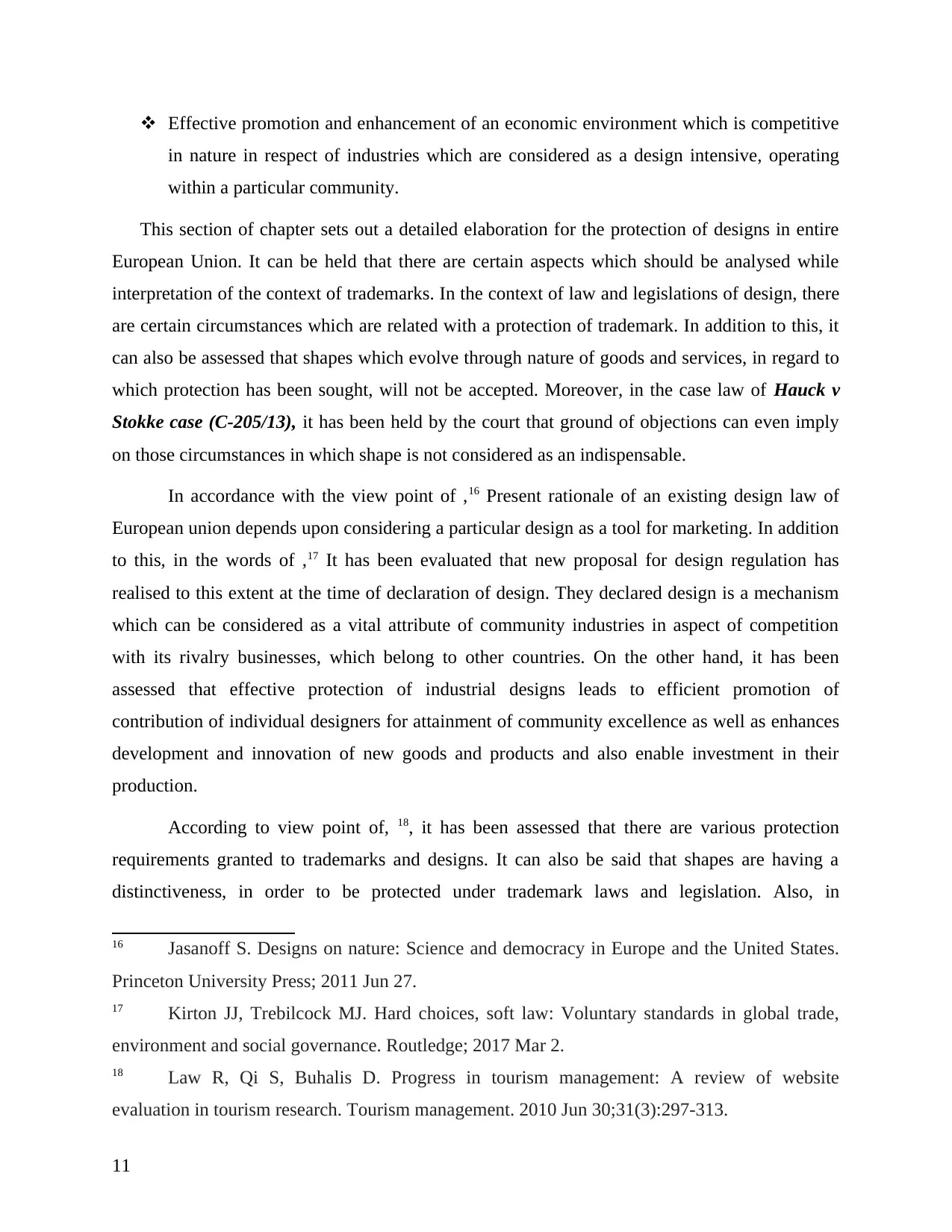
Effective promotion and enhancement of an economic environment which is competitive
in nature in respect of industries which are considered as a design intensive, operating
within a particular community.
This section of chapter sets out a detailed elaboration for the protection of designs in entire
European Union. It can be held that there are certain aspects which should be analysed while
interpretation of the context of trademarks. In the context of law and legislations of design, there
are certain circumstances which are related with a protection of trademark. In addition to this, it
can also be assessed that shapes which evolve through nature of goods and services, in regard to
which protection has been sought, will not be accepted. Moreover, in the case law of Hauck v
Stokke case (C-205/13), it has been held by the court that ground of objections can even imply
on those circumstances in which shape is not considered as an indispensable.
In accordance with the view point of ,16 Present rationale of an existing design law of
European union depends upon considering a particular design as a tool for marketing. In addition
to this, in the words of ,17 It has been evaluated that new proposal for design regulation has
realised to this extent at the time of declaration of design. They declared design is a mechanism
which can be considered as a vital attribute of community industries in aspect of competition
with its rivalry businesses, which belong to other countries. On the other hand, it has been
assessed that effective protection of industrial designs leads to efficient promotion of
contribution of individual designers for attainment of community excellence as well as enhances
development and innovation of new goods and products and also enable investment in their
production.
According to view point of, 18, it has been assessed that there are various protection
requirements granted to trademarks and designs. It can also be said that shapes are having a
distinctiveness, in order to be protected under trademark laws and legislation. Also, in
16 Jasanoff S. Designs on nature: Science and democracy in Europe and the United States.
Princeton University Press; 2011 Jun 27.
17 Kirton JJ, Trebilcock MJ. Hard choices, soft law: Voluntary standards in global trade,
environment and social governance. Routledge; 2017 Mar 2.
18 Law R, Qi S, Buhalis D. Progress in tourism management: A review of website
evaluation in tourism research. Tourism management. 2010 Jun 30;31(3):297-313.
11
in nature in respect of industries which are considered as a design intensive, operating
within a particular community.
This section of chapter sets out a detailed elaboration for the protection of designs in entire
European Union. It can be held that there are certain aspects which should be analysed while
interpretation of the context of trademarks. In the context of law and legislations of design, there
are certain circumstances which are related with a protection of trademark. In addition to this, it
can also be assessed that shapes which evolve through nature of goods and services, in regard to
which protection has been sought, will not be accepted. Moreover, in the case law of Hauck v
Stokke case (C-205/13), it has been held by the court that ground of objections can even imply
on those circumstances in which shape is not considered as an indispensable.
In accordance with the view point of ,16 Present rationale of an existing design law of
European union depends upon considering a particular design as a tool for marketing. In addition
to this, in the words of ,17 It has been evaluated that new proposal for design regulation has
realised to this extent at the time of declaration of design. They declared design is a mechanism
which can be considered as a vital attribute of community industries in aspect of competition
with its rivalry businesses, which belong to other countries. On the other hand, it has been
assessed that effective protection of industrial designs leads to efficient promotion of
contribution of individual designers for attainment of community excellence as well as enhances
development and innovation of new goods and products and also enable investment in their
production.
According to view point of, 18, it has been assessed that there are various protection
requirements granted to trademarks and designs. It can also be said that shapes are having a
distinctiveness, in order to be protected under trademark laws and legislation. Also, in
16 Jasanoff S. Designs on nature: Science and democracy in Europe and the United States.
Princeton University Press; 2011 Jun 27.
17 Kirton JJ, Trebilcock MJ. Hard choices, soft law: Voluntary standards in global trade,
environment and social governance. Routledge; 2017 Mar 2.
18 Law R, Qi S, Buhalis D. Progress in tourism management: A review of website
evaluation in tourism research. Tourism management. 2010 Jun 30;31(3):297-313.
11
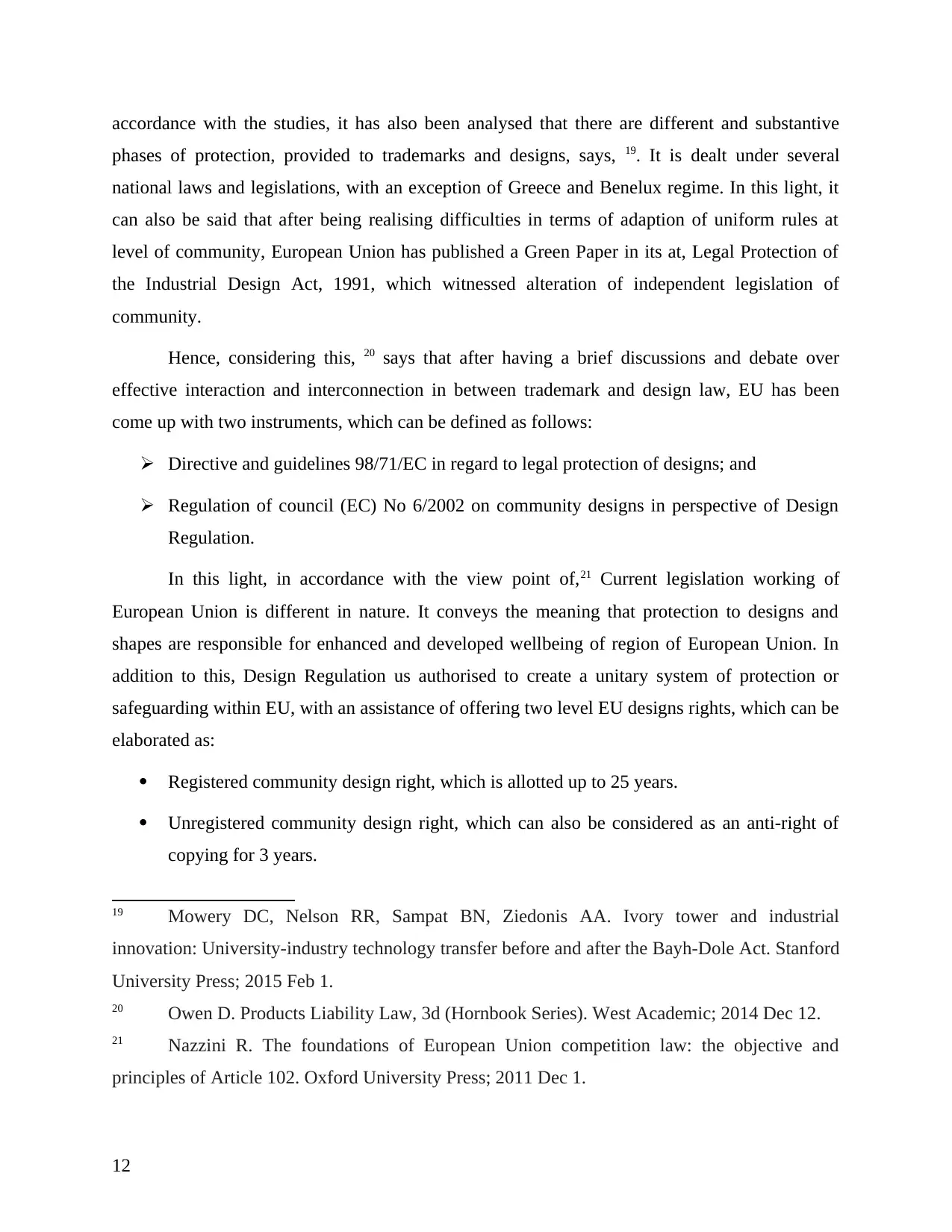
accordance with the studies, it has also been analysed that there are different and substantive
phases of protection, provided to trademarks and designs, says, 19. It is dealt under several
national laws and legislations, with an exception of Greece and Benelux regime. In this light, it
can also be said that after being realising difficulties in terms of adaption of uniform rules at
level of community, European Union has published a Green Paper in its at, Legal Protection of
the Industrial Design Act, 1991, which witnessed alteration of independent legislation of
community.
Hence, considering this, 20 says that after having a brief discussions and debate over
effective interaction and interconnection in between trademark and design law, EU has been
come up with two instruments, which can be defined as follows:
Directive and guidelines 98/71/EC in regard to legal protection of designs; and
Regulation of council (EC) No 6/2002 on community designs in perspective of Design
Regulation.
In this light, in accordance with the view point of,21 Current legislation working of
European Union is different in nature. It conveys the meaning that protection to designs and
shapes are responsible for enhanced and developed wellbeing of region of European Union. In
addition to this, Design Regulation us authorised to create a unitary system of protection or
safeguarding within EU, with an assistance of offering two level EU designs rights, which can be
elaborated as:
Registered community design right, which is allotted up to 25 years.
Unregistered community design right, which can also be considered as an anti-right of
copying for 3 years.
19 Mowery DC, Nelson RR, Sampat BN, Ziedonis AA. Ivory tower and industrial
innovation: University-industry technology transfer before and after the Bayh-Dole Act. Stanford
University Press; 2015 Feb 1.
20 Owen D. Products Liability Law, 3d (Hornbook Series). West Academic; 2014 Dec 12.
21 Nazzini R. The foundations of European Union competition law: the objective and
principles of Article 102. Oxford University Press; 2011 Dec 1.
12
phases of protection, provided to trademarks and designs, says, 19. It is dealt under several
national laws and legislations, with an exception of Greece and Benelux regime. In this light, it
can also be said that after being realising difficulties in terms of adaption of uniform rules at
level of community, European Union has published a Green Paper in its at, Legal Protection of
the Industrial Design Act, 1991, which witnessed alteration of independent legislation of
community.
Hence, considering this, 20 says that after having a brief discussions and debate over
effective interaction and interconnection in between trademark and design law, EU has been
come up with two instruments, which can be defined as follows:
Directive and guidelines 98/71/EC in regard to legal protection of designs; and
Regulation of council (EC) No 6/2002 on community designs in perspective of Design
Regulation.
In this light, in accordance with the view point of,21 Current legislation working of
European Union is different in nature. It conveys the meaning that protection to designs and
shapes are responsible for enhanced and developed wellbeing of region of European Union. In
addition to this, Design Regulation us authorised to create a unitary system of protection or
safeguarding within EU, with an assistance of offering two level EU designs rights, which can be
elaborated as:
Registered community design right, which is allotted up to 25 years.
Unregistered community design right, which can also be considered as an anti-right of
copying for 3 years.
19 Mowery DC, Nelson RR, Sampat BN, Ziedonis AA. Ivory tower and industrial
innovation: University-industry technology transfer before and after the Bayh-Dole Act. Stanford
University Press; 2015 Feb 1.
20 Owen D. Products Liability Law, 3d (Hornbook Series). West Academic; 2014 Dec 12.
21 Nazzini R. The foundations of European Union competition law: the objective and
principles of Article 102. Oxford University Press; 2011 Dec 1.
12
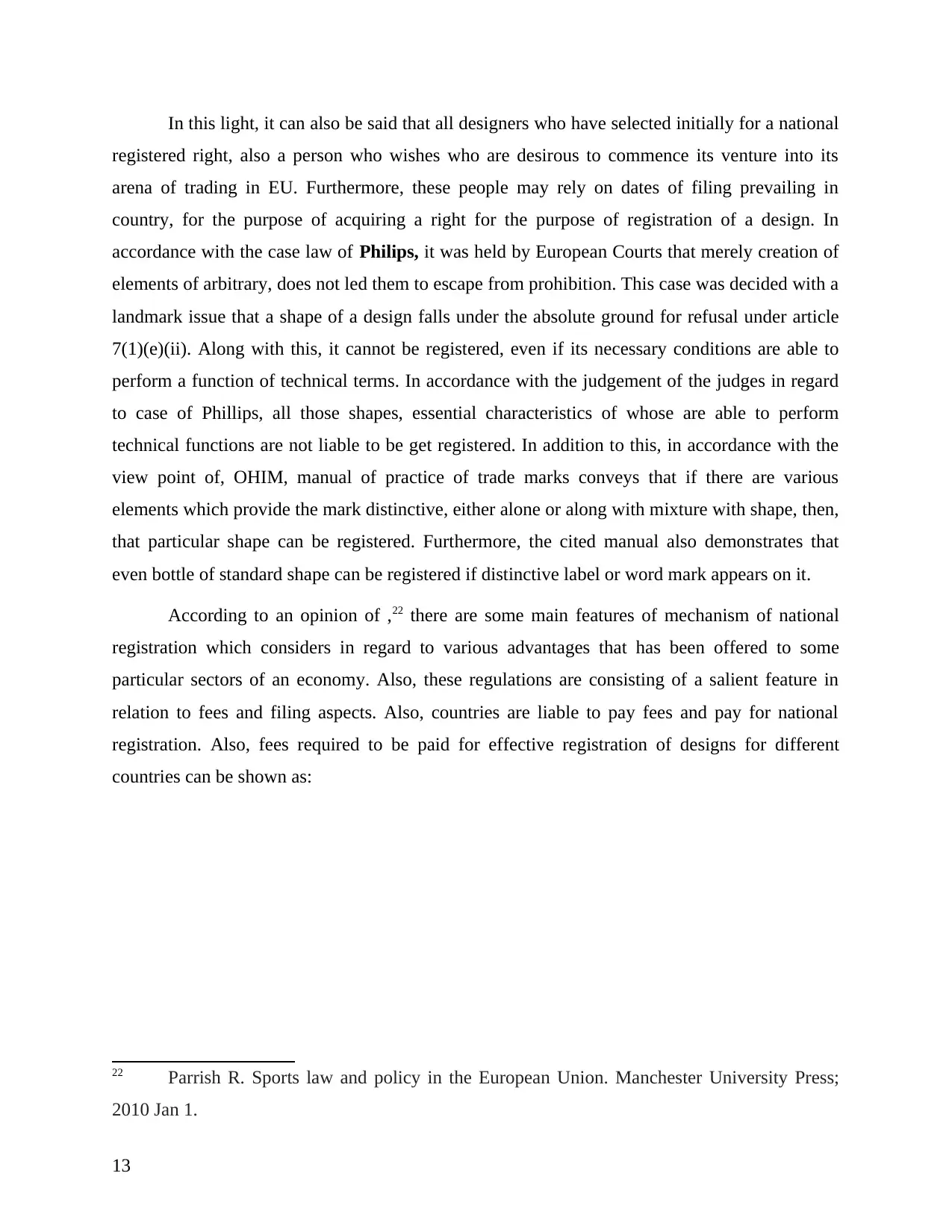
In this light, it can also be said that all designers who have selected initially for a national
registered right, also a person who wishes who are desirous to commence its venture into its
arena of trading in EU. Furthermore, these people may rely on dates of filing prevailing in
country, for the purpose of acquiring a right for the purpose of registration of a design. In
accordance with the case law of Philips, it was held by European Courts that merely creation of
elements of arbitrary, does not led them to escape from prohibition. This case was decided with a
landmark issue that a shape of a design falls under the absolute ground for refusal under article
7(1)(e)(ii). Along with this, it cannot be registered, even if its necessary conditions are able to
perform a function of technical terms. In accordance with the judgement of the judges in regard
to case of Phillips, all those shapes, essential characteristics of whose are able to perform
technical functions are not liable to be get registered. In addition to this, in accordance with the
view point of, OHIM, manual of practice of trade marks conveys that if there are various
elements which provide the mark distinctive, either alone or along with mixture with shape, then,
that particular shape can be registered. Furthermore, the cited manual also demonstrates that
even bottle of standard shape can be registered if distinctive label or word mark appears on it.
According to an opinion of ,22 there are some main features of mechanism of national
registration which considers in regard to various advantages that has been offered to some
particular sectors of an economy. Also, these regulations are consisting of a salient feature in
relation to fees and filing aspects. Also, countries are liable to pay fees and pay for national
registration. Also, fees required to be paid for effective registration of designs for different
countries can be shown as:
22 Parrish R. Sports law and policy in the European Union. Manchester University Press;
2010 Jan 1.
13
registered right, also a person who wishes who are desirous to commence its venture into its
arena of trading in EU. Furthermore, these people may rely on dates of filing prevailing in
country, for the purpose of acquiring a right for the purpose of registration of a design. In
accordance with the case law of Philips, it was held by European Courts that merely creation of
elements of arbitrary, does not led them to escape from prohibition. This case was decided with a
landmark issue that a shape of a design falls under the absolute ground for refusal under article
7(1)(e)(ii). Along with this, it cannot be registered, even if its necessary conditions are able to
perform a function of technical terms. In accordance with the judgement of the judges in regard
to case of Phillips, all those shapes, essential characteristics of whose are able to perform
technical functions are not liable to be get registered. In addition to this, in accordance with the
view point of, OHIM, manual of practice of trade marks conveys that if there are various
elements which provide the mark distinctive, either alone or along with mixture with shape, then,
that particular shape can be registered. Furthermore, the cited manual also demonstrates that
even bottle of standard shape can be registered if distinctive label or word mark appears on it.
According to an opinion of ,22 there are some main features of mechanism of national
registration which considers in regard to various advantages that has been offered to some
particular sectors of an economy. Also, these regulations are consisting of a salient feature in
relation to fees and filing aspects. Also, countries are liable to pay fees and pay for national
registration. Also, fees required to be paid for effective registration of designs for different
countries can be shown as:
22 Parrish R. Sports law and policy in the European Union. Manchester University Press;
2010 Jan 1.
13
Secure Best Marks with AI Grader
Need help grading? Try our AI Grader for instant feedback on your assignments.
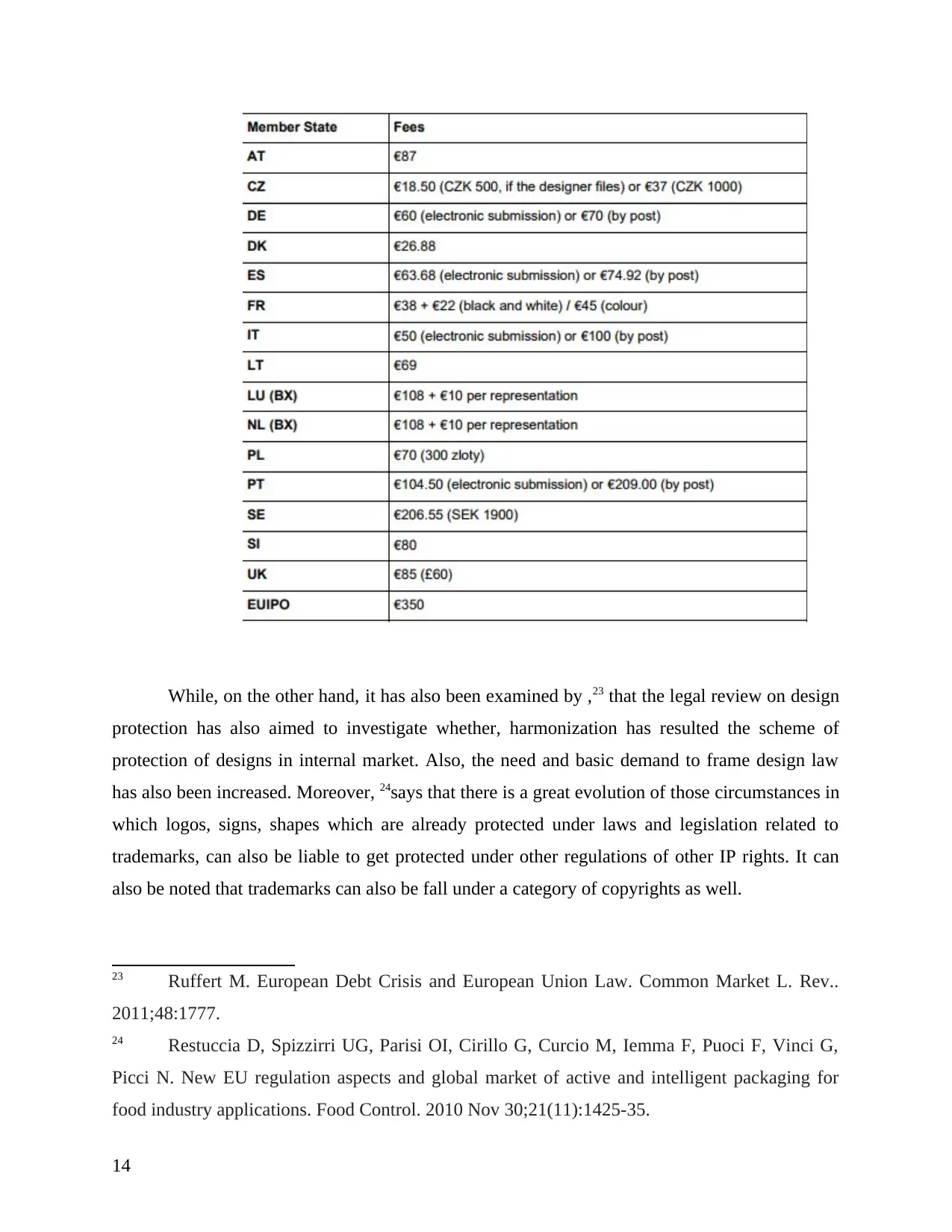
While, on the other hand, it has also been examined by ,23 that the legal review on design
protection has also aimed to investigate whether, harmonization has resulted the scheme of
protection of designs in internal market. Also, the need and basic demand to frame design law
has also been increased. Moreover, 24says that there is a great evolution of those circumstances in
which logos, signs, shapes which are already protected under laws and legislation related to
trademarks, can also be liable to get protected under other regulations of other IP rights. It can
also be noted that trademarks can also be fall under a category of copyrights as well.
23 Ruffert M. European Debt Crisis and European Union Law. Common Market L. Rev..
2011;48:1777.
24 Restuccia D, Spizzirri UG, Parisi OI, Cirillo G, Curcio M, Iemma F, Puoci F, Vinci G,
Picci N. New EU regulation aspects and global market of active and intelligent packaging for
food industry applications. Food Control. 2010 Nov 30;21(11):1425-35.
14
protection has also aimed to investigate whether, harmonization has resulted the scheme of
protection of designs in internal market. Also, the need and basic demand to frame design law
has also been increased. Moreover, 24says that there is a great evolution of those circumstances in
which logos, signs, shapes which are already protected under laws and legislation related to
trademarks, can also be liable to get protected under other regulations of other IP rights. It can
also be noted that trademarks can also be fall under a category of copyrights as well.
23 Ruffert M. European Debt Crisis and European Union Law. Common Market L. Rev..
2011;48:1777.
24 Restuccia D, Spizzirri UG, Parisi OI, Cirillo G, Curcio M, Iemma F, Puoci F, Vinci G,
Picci N. New EU regulation aspects and global market of active and intelligent packaging for
food industry applications. Food Control. 2010 Nov 30;21(11):1425-35.
14

In addition to this, it can be said that there overlap of protection is a concept which depicts that
there are various designs, which can be classified as registered trademarks have also been
registered as a design, but not versa.it is known as overlapping of protection. Hence, considering
this there is an overlap in between the registered shapes of designs and trademarks.
Also, in this light, it can also be laid down that if any shape of designs has a capability to
be registered as a trademarks, then such trademarks are able to be subjected to an additional basis
for rejection, when it is being compared to another signs as well, which is defined in article 7(1).
Furthermore, there are various exceptions which are laid down so as to give effect
exclusion of shapes as trademarks. These can be characterized as:
In this, main light has been thrown on a fact that there is a refusal to register a trademark
registration on a ground that if a particular sign does not consist of a shape of the good
itself or also a shape which has been considered as an important to attain technical result.
In addition to this, any sign, which comprises of any other characteristics, then it will be
eligible to refusal.
In this light, in the words of ,…. it is a notable fact that many criticizers comments on
many cases which are related to whether shapes are liable to get protected and safeguarded into
an arena of trademark protection. Also, overlapping basically occurs because of the reason that
all shapes are liable to be fall into an act of trademark if it satisfies conditions. In addition to this,
….. says that to act as a trademark, a sign or shape must act in accordance with the trade origin.
It can be well defined in the case of Dualit Limited’s; it was held by court that registration of
words which form a part of mutual parlance is not accepted or prohibited. Along with this, it is
equally pertinent to shape marks. There was another case law of Nestle Waters France v OHIM,
which had a great concern with ability of registration of a particular shape of a water bottle, that
a sign, which comprises of a combination of all components each and every of which are was
lacking of a distinguishing character, can serve as a basis of concrete evidence.
It is a notable fact that registration of shapes is considered to be progressed in
Europe, since the evolution of laws and legislations of Trademarks and the Community
Regulations of Trademarks. There is another case namely Lego juris v. OHIM, in which the
judges had not accepted and dismissed an appeal of Lego, which is against the decision of GC. It
15
there are various designs, which can be classified as registered trademarks have also been
registered as a design, but not versa.it is known as overlapping of protection. Hence, considering
this there is an overlap in between the registered shapes of designs and trademarks.
Also, in this light, it can also be laid down that if any shape of designs has a capability to
be registered as a trademarks, then such trademarks are able to be subjected to an additional basis
for rejection, when it is being compared to another signs as well, which is defined in article 7(1).
Furthermore, there are various exceptions which are laid down so as to give effect
exclusion of shapes as trademarks. These can be characterized as:
In this, main light has been thrown on a fact that there is a refusal to register a trademark
registration on a ground that if a particular sign does not consist of a shape of the good
itself or also a shape which has been considered as an important to attain technical result.
In addition to this, any sign, which comprises of any other characteristics, then it will be
eligible to refusal.
In this light, in the words of ,…. it is a notable fact that many criticizers comments on
many cases which are related to whether shapes are liable to get protected and safeguarded into
an arena of trademark protection. Also, overlapping basically occurs because of the reason that
all shapes are liable to be fall into an act of trademark if it satisfies conditions. In addition to this,
….. says that to act as a trademark, a sign or shape must act in accordance with the trade origin.
It can be well defined in the case of Dualit Limited’s; it was held by court that registration of
words which form a part of mutual parlance is not accepted or prohibited. Along with this, it is
equally pertinent to shape marks. There was another case law of Nestle Waters France v OHIM,
which had a great concern with ability of registration of a particular shape of a water bottle, that
a sign, which comprises of a combination of all components each and every of which are was
lacking of a distinguishing character, can serve as a basis of concrete evidence.
It is a notable fact that registration of shapes is considered to be progressed in
Europe, since the evolution of laws and legislations of Trademarks and the Community
Regulations of Trademarks. There is another case namely Lego juris v. OHIM, in which the
judges had not accepted and dismissed an appeal of Lego, which is against the decision of GC. It
15
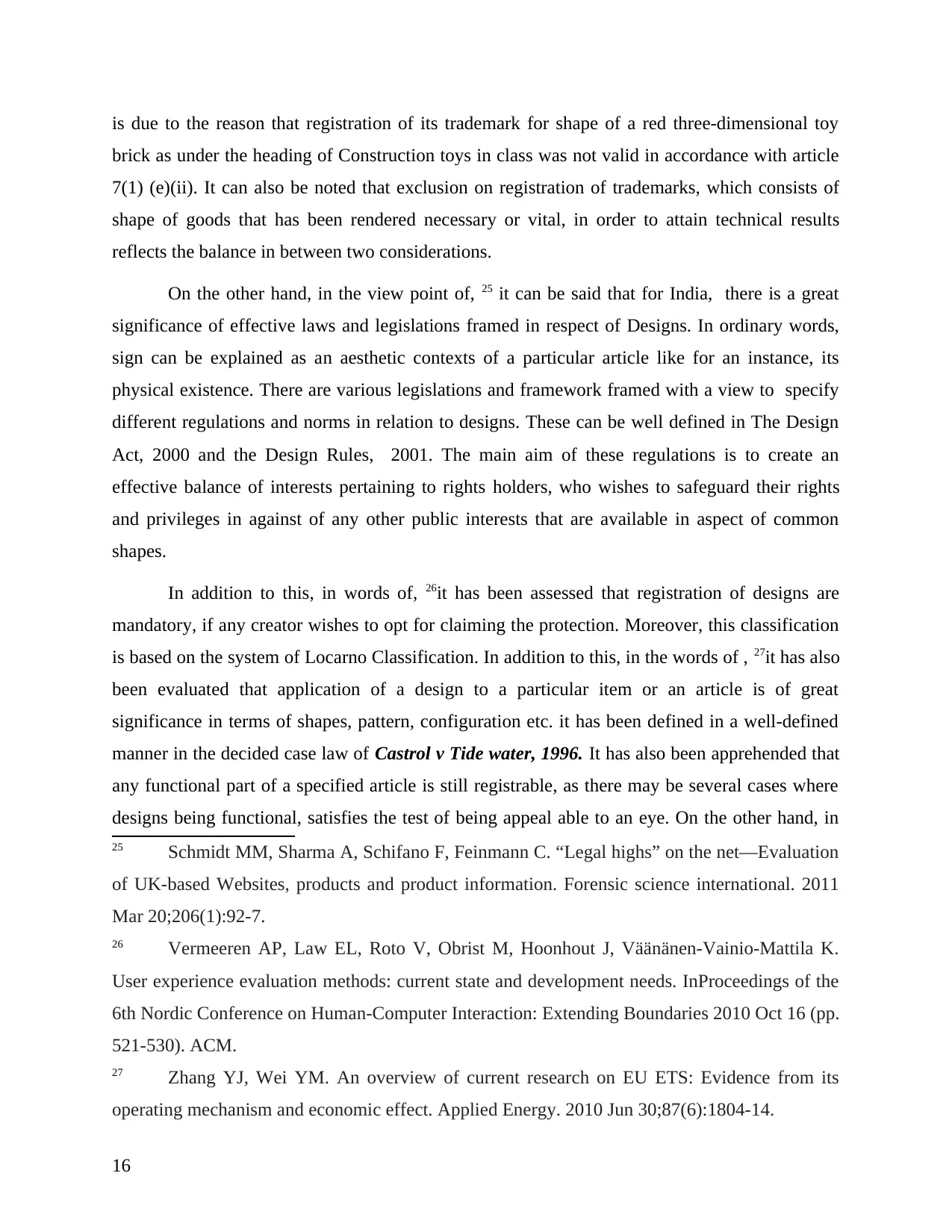
is due to the reason that registration of its trademark for shape of a red three-dimensional toy
brick as under the heading of Construction toys in class was not valid in accordance with article
7(1) (e)(ii). It can also be noted that exclusion on registration of trademarks, which consists of
shape of goods that has been rendered necessary or vital, in order to attain technical results
reflects the balance in between two considerations.
On the other hand, in the view point of, 25 it can be said that for India, there is a great
significance of effective laws and legislations framed in respect of Designs. In ordinary words,
sign can be explained as an aesthetic contexts of a particular article like for an instance, its
physical existence. There are various legislations and framework framed with a view to specify
different regulations and norms in relation to designs. These can be well defined in The Design
Act, 2000 and the Design Rules, 2001. The main aim of these regulations is to create an
effective balance of interests pertaining to rights holders, who wishes to safeguard their rights
and privileges in against of any other public interests that are available in aspect of common
shapes.
In addition to this, in words of, 26it has been assessed that registration of designs are
mandatory, if any creator wishes to opt for claiming the protection. Moreover, this classification
is based on the system of Locarno Classification. In addition to this, in the words of , 27it has also
been evaluated that application of a design to a particular item or an article is of great
significance in terms of shapes, pattern, configuration etc. it has been defined in a well-defined
manner in the decided case law of Castrol v Tide water, 1996. It has also been apprehended that
any functional part of a specified article is still registrable, as there may be several cases where
designs being functional, satisfies the test of being appeal able to an eye. On the other hand, in
25 Schmidt MM, Sharma A, Schifano F, Feinmann C. “Legal highs” on the net—Evaluation
of UK-based Websites, products and product information. Forensic science international. 2011
Mar 20;206(1):92-7.
26 Vermeeren AP, Law EL, Roto V, Obrist M, Hoonhout J, Väänänen-Vainio-Mattila K.
User experience evaluation methods: current state and development needs. InProceedings of the
6th Nordic Conference on Human-Computer Interaction: Extending Boundaries 2010 Oct 16 (pp.
521-530). ACM.
27 Zhang YJ, Wei YM. An overview of current research on EU ETS: Evidence from its
operating mechanism and economic effect. Applied Energy. 2010 Jun 30;87(6):1804-14.
16
brick as under the heading of Construction toys in class was not valid in accordance with article
7(1) (e)(ii). It can also be noted that exclusion on registration of trademarks, which consists of
shape of goods that has been rendered necessary or vital, in order to attain technical results
reflects the balance in between two considerations.
On the other hand, in the view point of, 25 it can be said that for India, there is a great
significance of effective laws and legislations framed in respect of Designs. In ordinary words,
sign can be explained as an aesthetic contexts of a particular article like for an instance, its
physical existence. There are various legislations and framework framed with a view to specify
different regulations and norms in relation to designs. These can be well defined in The Design
Act, 2000 and the Design Rules, 2001. The main aim of these regulations is to create an
effective balance of interests pertaining to rights holders, who wishes to safeguard their rights
and privileges in against of any other public interests that are available in aspect of common
shapes.
In addition to this, in words of, 26it has been assessed that registration of designs are
mandatory, if any creator wishes to opt for claiming the protection. Moreover, this classification
is based on the system of Locarno Classification. In addition to this, in the words of , 27it has also
been evaluated that application of a design to a particular item or an article is of great
significance in terms of shapes, pattern, configuration etc. it has been defined in a well-defined
manner in the decided case law of Castrol v Tide water, 1996. It has also been apprehended that
any functional part of a specified article is still registrable, as there may be several cases where
designs being functional, satisfies the test of being appeal able to an eye. On the other hand, in
25 Schmidt MM, Sharma A, Schifano F, Feinmann C. “Legal highs” on the net—Evaluation
of UK-based Websites, products and product information. Forensic science international. 2011
Mar 20;206(1):92-7.
26 Vermeeren AP, Law EL, Roto V, Obrist M, Hoonhout J, Väänänen-Vainio-Mattila K.
User experience evaluation methods: current state and development needs. InProceedings of the
6th Nordic Conference on Human-Computer Interaction: Extending Boundaries 2010 Oct 16 (pp.
521-530). ACM.
27 Zhang YJ, Wei YM. An overview of current research on EU ETS: Evidence from its
operating mechanism and economic effect. Applied Energy. 2010 Jun 30;87(6):1804-14.
16
Paraphrase This Document
Need a fresh take? Get an instant paraphrase of this document with our AI Paraphraser
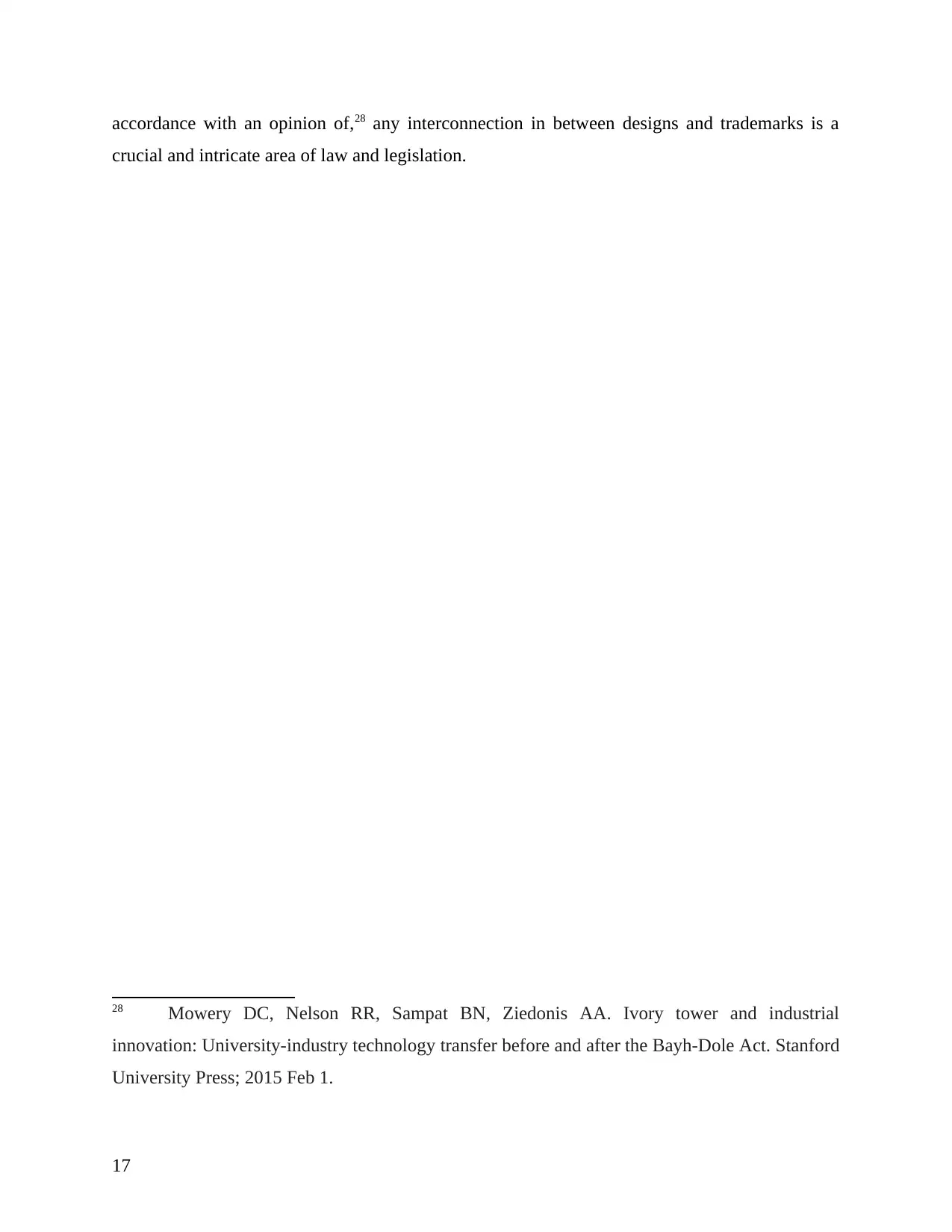
accordance with an opinion of,28 any interconnection in between designs and trademarks is a
crucial and intricate area of law and legislation.
28 Mowery DC, Nelson RR, Sampat BN, Ziedonis AA. Ivory tower and industrial
innovation: University-industry technology transfer before and after the Bayh-Dole Act. Stanford
University Press; 2015 Feb 1.
17
crucial and intricate area of law and legislation.
28 Mowery DC, Nelson RR, Sampat BN, Ziedonis AA. Ivory tower and industrial
innovation: University-industry technology transfer before and after the Bayh-Dole Act. Stanford
University Press; 2015 Feb 1.
17
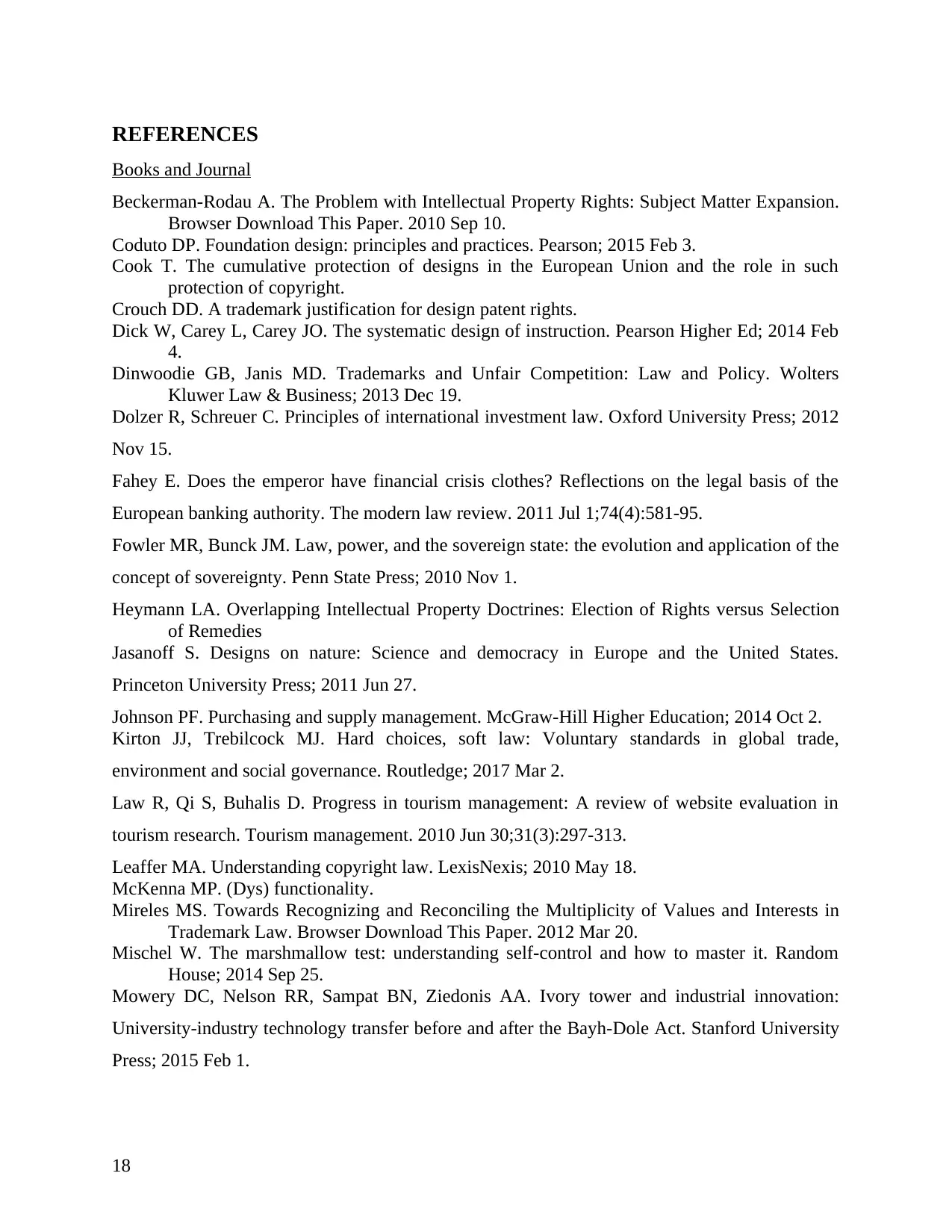
REFERENCES
Books and Journal
Beckerman-Rodau A. The Problem with Intellectual Property Rights: Subject Matter Expansion.
Browser Download This Paper. 2010 Sep 10.
Coduto DP. Foundation design: principles and practices. Pearson; 2015 Feb 3.
Cook T. The cumulative protection of designs in the European Union and the role in such
protection of copyright.
Crouch DD. A trademark justification for design patent rights.
Dick W, Carey L, Carey JO. The systematic design of instruction. Pearson Higher Ed; 2014 Feb
4.
Dinwoodie GB, Janis MD. Trademarks and Unfair Competition: Law and Policy. Wolters
Kluwer Law & Business; 2013 Dec 19.
Dolzer R, Schreuer C. Principles of international investment law. Oxford University Press; 2012
Nov 15.
Fahey E. Does the emperor have financial crisis clothes? Reflections on the legal basis of the
European banking authority. The modern law review. 2011 Jul 1;74(4):581-95.
Fowler MR, Bunck JM. Law, power, and the sovereign state: the evolution and application of the
concept of sovereignty. Penn State Press; 2010 Nov 1.
Heymann LA. Overlapping Intellectual Property Doctrines: Election of Rights versus Selection
of Remedies
Jasanoff S. Designs on nature: Science and democracy in Europe and the United States.
Princeton University Press; 2011 Jun 27.
Johnson PF. Purchasing and supply management. McGraw-Hill Higher Education; 2014 Oct 2.
Kirton JJ, Trebilcock MJ. Hard choices, soft law: Voluntary standards in global trade,
environment and social governance. Routledge; 2017 Mar 2.
Law R, Qi S, Buhalis D. Progress in tourism management: A review of website evaluation in
tourism research. Tourism management. 2010 Jun 30;31(3):297-313.
Leaffer MA. Understanding copyright law. LexisNexis; 2010 May 18.
McKenna MP. (Dys) functionality.
Mireles MS. Towards Recognizing and Reconciling the Multiplicity of Values and Interests in
Trademark Law. Browser Download This Paper. 2012 Mar 20.
Mischel W. The marshmallow test: understanding self-control and how to master it. Random
House; 2014 Sep 25.
Mowery DC, Nelson RR, Sampat BN, Ziedonis AA. Ivory tower and industrial innovation:
University-industry technology transfer before and after the Bayh-Dole Act. Stanford University
Press; 2015 Feb 1.
18
Books and Journal
Beckerman-Rodau A. The Problem with Intellectual Property Rights: Subject Matter Expansion.
Browser Download This Paper. 2010 Sep 10.
Coduto DP. Foundation design: principles and practices. Pearson; 2015 Feb 3.
Cook T. The cumulative protection of designs in the European Union and the role in such
protection of copyright.
Crouch DD. A trademark justification for design patent rights.
Dick W, Carey L, Carey JO. The systematic design of instruction. Pearson Higher Ed; 2014 Feb
4.
Dinwoodie GB, Janis MD. Trademarks and Unfair Competition: Law and Policy. Wolters
Kluwer Law & Business; 2013 Dec 19.
Dolzer R, Schreuer C. Principles of international investment law. Oxford University Press; 2012
Nov 15.
Fahey E. Does the emperor have financial crisis clothes? Reflections on the legal basis of the
European banking authority. The modern law review. 2011 Jul 1;74(4):581-95.
Fowler MR, Bunck JM. Law, power, and the sovereign state: the evolution and application of the
concept of sovereignty. Penn State Press; 2010 Nov 1.
Heymann LA. Overlapping Intellectual Property Doctrines: Election of Rights versus Selection
of Remedies
Jasanoff S. Designs on nature: Science and democracy in Europe and the United States.
Princeton University Press; 2011 Jun 27.
Johnson PF. Purchasing and supply management. McGraw-Hill Higher Education; 2014 Oct 2.
Kirton JJ, Trebilcock MJ. Hard choices, soft law: Voluntary standards in global trade,
environment and social governance. Routledge; 2017 Mar 2.
Law R, Qi S, Buhalis D. Progress in tourism management: A review of website evaluation in
tourism research. Tourism management. 2010 Jun 30;31(3):297-313.
Leaffer MA. Understanding copyright law. LexisNexis; 2010 May 18.
McKenna MP. (Dys) functionality.
Mireles MS. Towards Recognizing and Reconciling the Multiplicity of Values and Interests in
Trademark Law. Browser Download This Paper. 2012 Mar 20.
Mischel W. The marshmallow test: understanding self-control and how to master it. Random
House; 2014 Sep 25.
Mowery DC, Nelson RR, Sampat BN, Ziedonis AA. Ivory tower and industrial innovation:
University-industry technology transfer before and after the Bayh-Dole Act. Stanford University
Press; 2015 Feb 1.
18
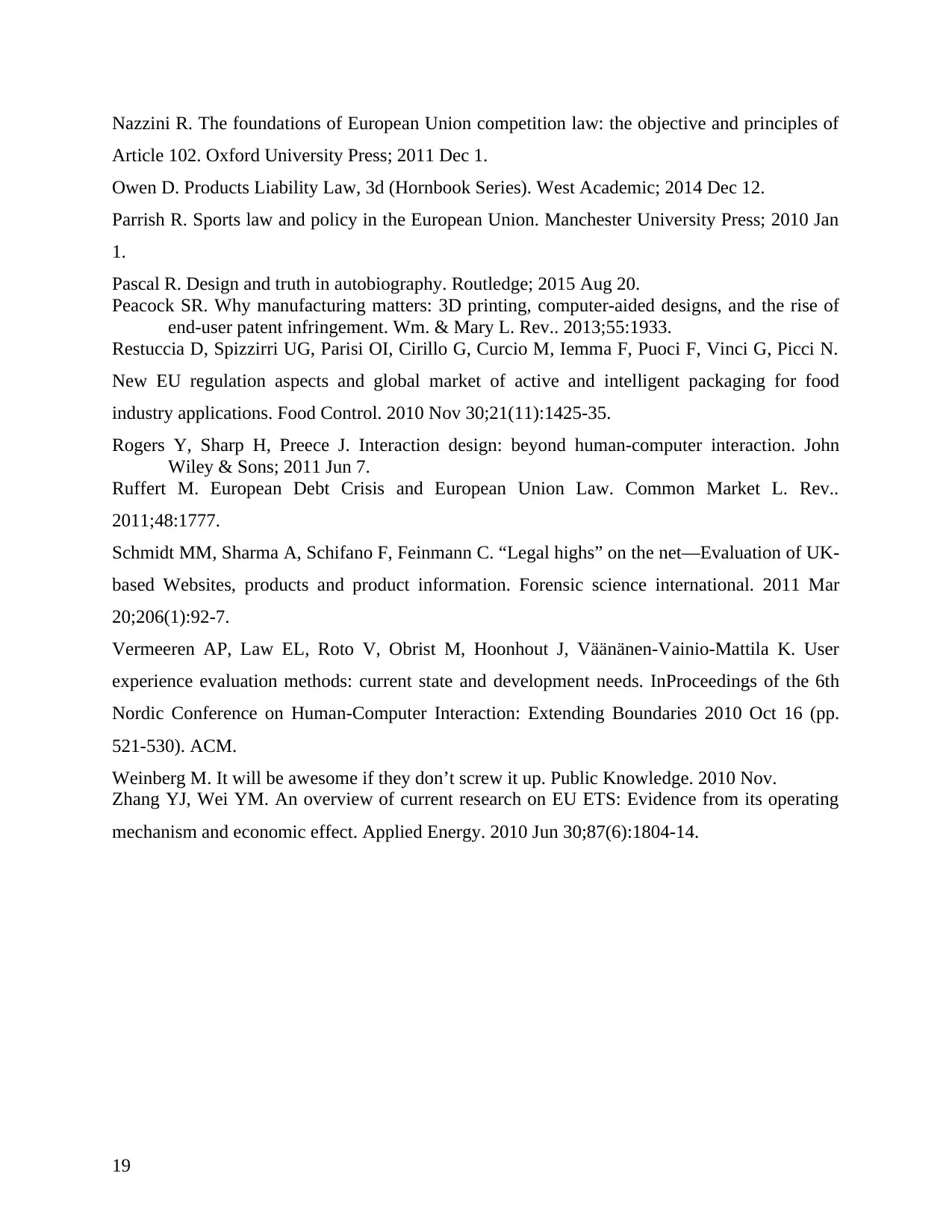
Nazzini R. The foundations of European Union competition law: the objective and principles of
Article 102. Oxford University Press; 2011 Dec 1.
Owen D. Products Liability Law, 3d (Hornbook Series). West Academic; 2014 Dec 12.
Parrish R. Sports law and policy in the European Union. Manchester University Press; 2010 Jan
1.
Pascal R. Design and truth in autobiography. Routledge; 2015 Aug 20.
Peacock SR. Why manufacturing matters: 3D printing, computer-aided designs, and the rise of
end-user patent infringement. Wm. & Mary L. Rev.. 2013;55:1933.
Restuccia D, Spizzirri UG, Parisi OI, Cirillo G, Curcio M, Iemma F, Puoci F, Vinci G, Picci N.
New EU regulation aspects and global market of active and intelligent packaging for food
industry applications. Food Control. 2010 Nov 30;21(11):1425-35.
Rogers Y, Sharp H, Preece J. Interaction design: beyond human-computer interaction. John
Wiley & Sons; 2011 Jun 7.
Ruffert M. European Debt Crisis and European Union Law. Common Market L. Rev..
2011;48:1777.
Schmidt MM, Sharma A, Schifano F, Feinmann C. “Legal highs” on the net—Evaluation of UK-
based Websites, products and product information. Forensic science international. 2011 Mar
20;206(1):92-7.
Vermeeren AP, Law EL, Roto V, Obrist M, Hoonhout J, Väänänen-Vainio-Mattila K. User
experience evaluation methods: current state and development needs. InProceedings of the 6th
Nordic Conference on Human-Computer Interaction: Extending Boundaries 2010 Oct 16 (pp.
521-530). ACM.
Weinberg M. It will be awesome if they don’t screw it up. Public Knowledge. 2010 Nov.
Zhang YJ, Wei YM. An overview of current research on EU ETS: Evidence from its operating
mechanism and economic effect. Applied Energy. 2010 Jun 30;87(6):1804-14.
19
Article 102. Oxford University Press; 2011 Dec 1.
Owen D. Products Liability Law, 3d (Hornbook Series). West Academic; 2014 Dec 12.
Parrish R. Sports law and policy in the European Union. Manchester University Press; 2010 Jan
1.
Pascal R. Design and truth in autobiography. Routledge; 2015 Aug 20.
Peacock SR. Why manufacturing matters: 3D printing, computer-aided designs, and the rise of
end-user patent infringement. Wm. & Mary L. Rev.. 2013;55:1933.
Restuccia D, Spizzirri UG, Parisi OI, Cirillo G, Curcio M, Iemma F, Puoci F, Vinci G, Picci N.
New EU regulation aspects and global market of active and intelligent packaging for food
industry applications. Food Control. 2010 Nov 30;21(11):1425-35.
Rogers Y, Sharp H, Preece J. Interaction design: beyond human-computer interaction. John
Wiley & Sons; 2011 Jun 7.
Ruffert M. European Debt Crisis and European Union Law. Common Market L. Rev..
2011;48:1777.
Schmidt MM, Sharma A, Schifano F, Feinmann C. “Legal highs” on the net—Evaluation of UK-
based Websites, products and product information. Forensic science international. 2011 Mar
20;206(1):92-7.
Vermeeren AP, Law EL, Roto V, Obrist M, Hoonhout J, Väänänen-Vainio-Mattila K. User
experience evaluation methods: current state and development needs. InProceedings of the 6th
Nordic Conference on Human-Computer Interaction: Extending Boundaries 2010 Oct 16 (pp.
521-530). ACM.
Weinberg M. It will be awesome if they don’t screw it up. Public Knowledge. 2010 Nov.
Zhang YJ, Wei YM. An overview of current research on EU ETS: Evidence from its operating
mechanism and economic effect. Applied Energy. 2010 Jun 30;87(6):1804-14.
19
Secure Best Marks with AI Grader
Need help grading? Try our AI Grader for instant feedback on your assignments.

20
1 out of 20
Related Documents
Your All-in-One AI-Powered Toolkit for Academic Success.
+13062052269
info@desklib.com
Available 24*7 on WhatsApp / Email
![[object Object]](/_next/static/media/star-bottom.7253800d.svg)
Unlock your academic potential
© 2024 | Zucol Services PVT LTD | All rights reserved.



